Motorola Solutions 89FT7036 Portable 2-Way Radio User Manual Neo Display User Guide 1 2
Motorola Solutions, Inc. Portable 2-Way Radio Neo Display User Guide 1 2
Users Manual
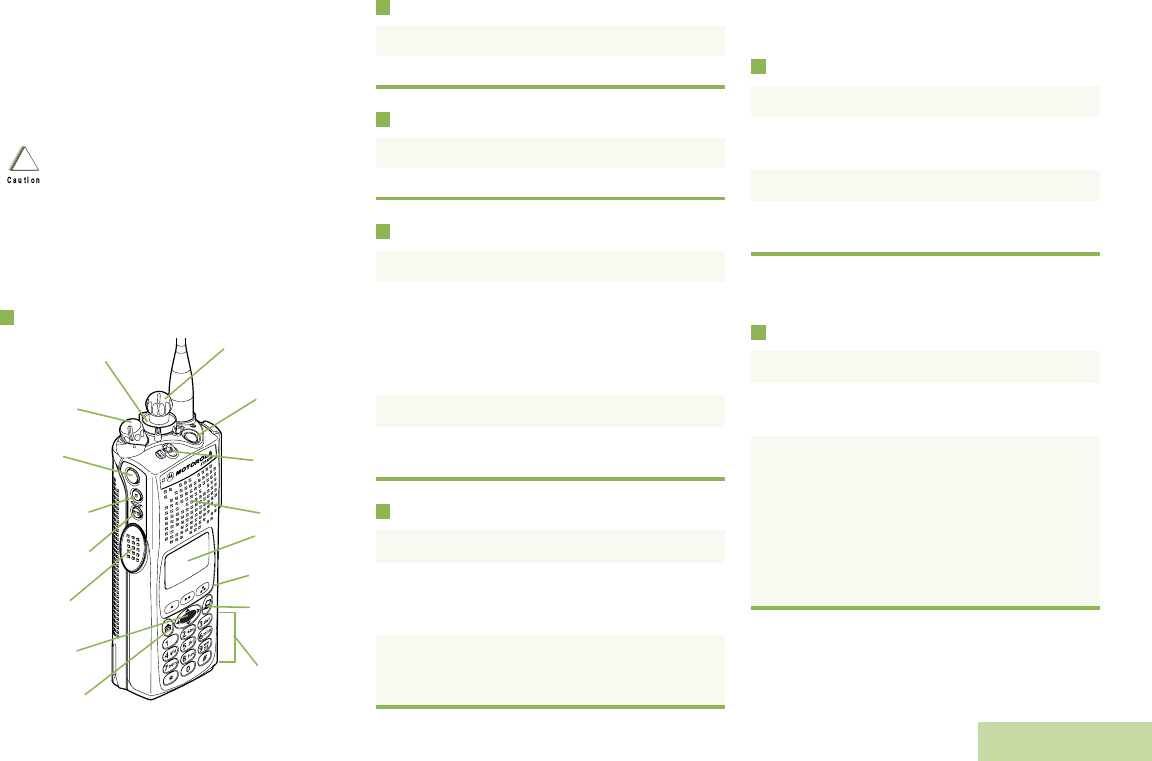
English
m
ASTRO® APX™ 7000 Series
Digital Portable Radios
Quick Reference Card
Product Safety and RF Exposure Compliance
ATTENTION!
This radio is restricted to occupational use only to satisfy FCC RF
energy exposure requirements. Before using this product, read
the RF energy awareness information and operating instructions
in the Product Safety and RF Exposure booklet enclosed with
your radio (Motorola Publication part number 6881095C98) to
ensure compliance with RF energy exposure limits.
Radio Controls (diagram to be replaced)
Radio On/Off
Zones and Channels
Receiving and Transmitting
Sending an Emergency Alarm
To exit emergency at any time, press and hold
the Emergency button.
Sending an Emergency Call
To exit emergency at any time, press and hold
the Emergency button.
Sending a Silent Emergency Call
To exit emergency at any time, press and hold
the Emergency button.
Before using this product, read the operating instructions
for safe usage contained in the Product Safety and RF
Exposure booklet enclosed with your radio.
!
16-Position
Select Knob
_ _ _ _ _ _ _
Speaker/Mic
Top Button
_ _ _ _ _ _ _
Concentric
Switch
_ _ _ _ _ _
Display
Keypad
Menu Select
Buttons
App Button
(TMS Button)
Top Side
Button
_ _ _ _ _ _ _
On/Off/
Volume Knob
Side Button 1
_ _ _ _ _ _ _
Side Button 2
_ _ _ _ _ _ _
PTT Button
3-Position
Switch
_ _ _ _ _ _ _
4-Way
Navigation
Button
Home Button
•On – On/Off/Volume knob clockwise.
•Off – On/Off/Volume knob counterclockwise.
•Zone – Zone switch to desired zone.
•Channel – Channel switch to desired channel.
1Select zone/channel.
2Listen for a transmission.
OR
Press and hold Volume Set button.
OR
Press Monitor button and listen for activity.
3Adjust volume, if necessary.
4Press the PTT button to transmit; release to
receive.
1Press the Emergency button.
2Display shows current zone/channel, and
EMERGENCY. LED lights up solid red, and a
short, medium-pitched tone sounds.
3When acknowledgment is received, you hear
four beeps; alarm ends; and radio exits
emergency.
1Press the Emergency button.
2Press and hold PTT. Speak clearly into the
microphone.
3Release the PTT button to end call.
4Press and hold Emergency button to exit
emergency.
1Press the Emergency button.
2Display does not change; the LED does not
light up, and there is no tone.
3Silent emergency continues until you:
Press and hold the Emergency button to exit
emergency state.
OR
Press and release the PTT button to exit silent
emergency mode and enter regular
emergency (alarm, call, or alarm with call)
mode.
6875945M01-A_Full.book Page 1 Tuesday, July 8, 2008 12:54 AM
this diagram will be replaced
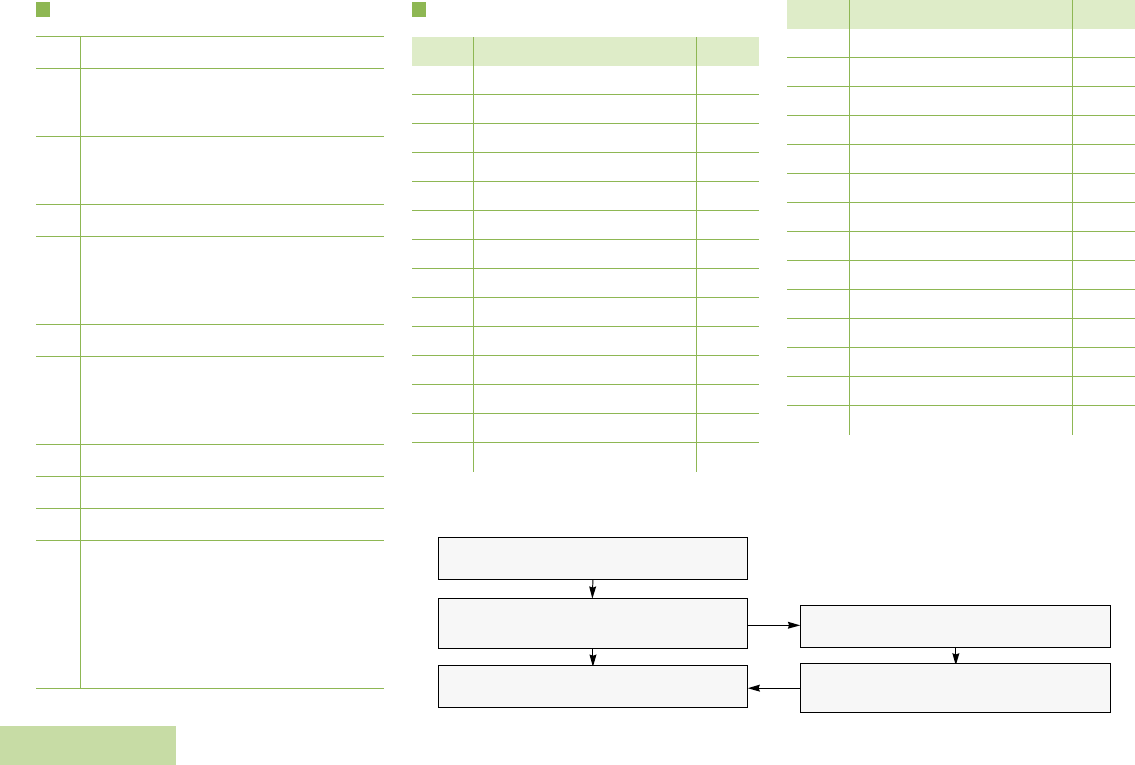
English
Display Status Icons Menu Entries (Use with Menu Navigation)
Receiving an individual call.
The radio is in the view or program mode.
On Steady = View mode
Blinking = Program mode
Received signal strength for the current
site (trunking only). The more stripes in
the icon, the stronger the signal.
Blinks when the battery is low.
You are talking directly to another radio or
through a repeater.
On = direct
Off = repeater
This channel is being monitored.
Your radio is in secure operation;
On = secure operation;
Off = clear operation; Blinking =
receiving an encrypted voice call
The radio is scanning a scan list.
Priority 1 Channel during scan.
Priority 2 Channel during scan
Indicates status of the location signal;
Off = Location feature disabled, or
insufficient battery power in location
accessory device; Blinking = Location
feature enabled, but no location signal
available; On = Location feature enabled,
and location signal available
Entry Menu Selection Page
BATT Smart Battery 82
CALL Private Call/Selective Call 25/31
CHAN Select a Channel 24
CLCK Set the Time and Date 78
DIR Repeater/Direct 28
ERAS Key Zeroization 65
KEY Key Selection 64
KSET Keyset Selection 64
LOGF Radio Lock 68
MUTE Keypad Mute 77
NAME Text Select 35
NUM Number Select 35
LOC Location 71
PAGE Call Alert Page 46
PHON Phone 25
PROG Editing 35
PSWD Password 68
PWR TX Power Level 76
REKY Rekey Request 66
RPGM Reprogram Request 34
SCAN Scan On/Off 43
SITE Site Lock/Unlock 75
STS Status Call 33
TGRP Talkgroup Call 32
TMS Text Messaging 54
USER User Login 51
VIEW View a List 39
ZONE Select a Zone 23
Entry Menu Selection Page
Menu Navigation
> to find Menu Entry
{, or |, or } directly below
Menu Entry to select
H to exit
< or > to scroll through sub-list
{, or |, or } directly below
Menu Entry to select
6875945M01-A_Full.book Page 2 Tuesday, July 8, 2008 12:54 AM

Contents
English
iii
Contents
This User Guide contains all the information you need
to use the APX™ 7000 Series Digital Portable Radios.
.......................................... . . . . . . . . . . . . . . . . . . . . . i
Important Safety Information . . . . . . . . . . . . . . . . . ix
Product Safety and RF Exposure Compliance . . .ix
Computer Software Copyrights . . . . . . . . . . . . . . . ix
Documentation Copyrights . . . . . . . . . . . . . . . . . . . . x
Disclaimer . . . . . . . . . . . . . . . . . . . . . . . . . . . . . . . . . . x
Getting Started . . . . . . . . . . . . . . . . . . . . . . . . . . . . . . 1
How to Use This Guide . . . . . . . . . . . . . . . . . . . . . . . 1
Notations Used in This Manual . . . . . . . . . . . . . . . . . 1
What Your Dealer/System Administrator
Can Tell You . . . . . . . . . . . . . . . . . . . . . . . . . . . . . . 2
Preparing Your Radio for Use . . . . . . . . . . . . . . . . . . 2
Charging the Battery . . . . . . . . . . . . . . . . . . . . . . . . . 2
Battery Charger . . . . . . . . . . . . . . . . . . . . . . . . . . . 3
Attaching the Battery . . . . . . . . . . . . . . . . . . . . . . . . . 3
Attaching the Antenna . . . . . . . . . . . . . . . . . . . . . . . . 4
Attaching the Belt Clip . . . . . . . . . . . . . . . . . . . . . . . . 4
Attaching the Universal Connector Cover . . . . . . . . . 5
Turning On the Radio . . . . . . . . . . . . . . . . . . . . . . . . 5
Adjusting the Volume . . . . . . . . . . . . . . . . . . . . . . . . 6
Identifying Radio Controls . . . . . . . . . . . . . . . . . . . . 6
Radio Controls You Will Be Using . . . . . . . . . . . . . . 7
Programmable Features . . . . . . . . . . . . . . . . . . . . . . 8
Assignable Radio Functions . . . . . . . . . . . . . . . . . 8
Assignable Settings or Utility Functions . . . . . . . . . 9
Accessing the Preprogrammed Functions . . . . . . . 10
Accessing the Menu Entry Features . . . . . . . . . . 10
Using the Menu Select Buttons . . . . . . . . . . . . . . 11
Using the Navigation Buttons . . . . . . . . . . . . . . . 11
Home Button . . . . . . . . . . . . . . . . . . . . . . . . . . . 11
App Button (TMS Feature Button) . . . . . . . . . . 11
4-Way Navigation Button . . . . . . . . . . . . . . . . . 11
Using the Keypad . . . . . . . . . . . . . . . . . . . . . . . . . . 12
Keypad Characters . . . . . . . . . . . . . . . . . . . . . . . 12
Push-To-Talk (PTT) Button . . . . . . . . . . . . . . . . . . . 13
Identifying Status Indicators . . . . . . . . . . . . . . . . . . 13
Status Icons . . . . . . . . . . . . . . . . . . . . . . . . . . . . . . 13
Text Messaging Service (TMS) . . . . . . . . . . . . . . . . 15
Status Icons . . . . . . . . . . . . . . . . . . . . . . . . . . . . . 15
Menu Options . . . . . . . . . . . . . . . . . . . . . . . . . . . 16
LED Indicator . . . . . . . . . . . . . . . . . . . . . . . . . . . . . 17
Intelligence Lighting Indicators . . . . . . . . . . . . . . . . 18
Alert Tones . . . . . . . . . . . . . . . . . . . . . . . . . . . . . . . 19
Phone Call Display and Alert Prompts . . . . . . . . . . 22
6875945M01-A_Full.book Page iii Tuesday, July 8, 2008 12:54 AM

Contents
English
iv
General Radio Operation . . . . . . . . . . . . . . . . . . . . 23
Selecting a Zone . . . . . . . . . . . . . . . . . . . . . . . . . . 23
Selecting a Radio Channel . . . . . . . . . . . . . . . . . . . 24
Receiving and Responding to a Radio Call . . . . . . 24
Receiving and Responding to a
Talkgroup Call . . . . . . . . . . . . . . . . . . . . . . . . . . . 24
Receiving and Responding to a Private
Call (Trunking Only) . . . . . . . . . . . . . . . . . . . . . . 25
Receiving and Responding to a
Telephone Call (Trunking Only) . . . . . . . . . . . . . 25
Making a Radio Call . . . . . . . . . . . . . . . . . . . . . . . . 26
Making a Talkgroup Call . . . . . . . . . . . . . . . . . . . 26
Making a Private Call (Trunking Only) . . . . . . . . 27
Making a Telephone Call (Trunking Only) . . . . . 27
Repeater or Direct Operation . . . . . . . . . . . . . . . . . 28
Monitoring Features . . . . . . . . . . . . . . . . . . . . . . . . 29
Monitoring a Channel . . . . . . . . . . . . . . . . . . . . . 29
Conventional Mode Operation . . . . . . . . . . . . . . 30
Advanced Features . . . . . . . . . . . . . . . . . . . . . . . . . 31
Advanced Call Features . . . . . . . . . . . . . . . . . . . . . 31
Receiving and Making a Selective Call
(ASTRO Conventional Only) . . . . . . . . . . . . . . . . 31
Receiving a Selective Call . . . . . . . . . . . . . . . . 31
Making a Selective Call . . . . . . . . . . . . . . . . . . 32
Using the Talkgroup Call Feature
(Conventional Operation Only) . . . . . . . . . . . . . . 32
Selecting a Talkgroup . . . . . . . . . . . . . . . . . . . 32
Sending a Status Call (ASTRO 25
Trunking Only) . . . . . . . . . . . . . . . . . . . . . . . . . . 33
Using the Dynamic Regrouping Feature
(Trunking Only) . . . . . . . . . . . . . . . . . . . . . . . . . . 33
Requesting a Reprogram (ASTRO 25
Trunking Only) . . . . . . . . . . . . . . . . . . . . . . . . . 34
Classifying Regrouped Radios . . . . . . . . . . . . 34
Contacts . . . . . . . . . . . . . . . . . . . . . . . . . . . . . . . . . 35
Making a Private Call from Contacts . . . . . . . . . . 36
Adding a New Contact Entry . . . . . . . . . . . . . . . . 37
Deleting a Contact Entry . . . . . . . . . . . . . . . . . . . 37
Adding a Contact to a Call List . . . . . . . . . . . . . . 38
Editing a Contact in a Call List . . . . . . . . . . . . . . 38
Editing an Entry Alias . . . . . . . . . . . . . . . . . . . . 38
Editing as Entry ID . . . . . . . . . . . . . . . . . . . . . . 38
Editing a Call Type . . . . . . . . . . . . . . . . . . . . . . 39
Viewing a Details of a Contact . . . . . . . . . . . . . . 39
Scan Lists . . . . . . . . . . . . . . . . . . . . . . . . . . . . . . . . 40
Viewing a Scan List . . . . . . . . . . . . . . . . . . . . . . . 40
Editing the Scan List . . . . . . . . . . . . . . . . . . . . . . 41
Changing the Scan List Status . . . . . . . . . . . . 42
Viewing and Changing the Priority Status . . . . 42
6875945M01-A_Full.book Page iv Tuesday, July 8, 2008 12:54 AM

Contents
English
v
Scan . . . . . . . . . . . . . . . . . . . . . . . . . . . . . . . . . . . . 43
Turning Scan On or Off . . . . . . . . . . . . . . . . . . . . 43
Making a Dynamic Priority Change
(Conventional Scan Only) . . . . . . . . . . . . . . . . . . 44
Deleting a Nuisance Channel . . . . . . . . . . . . . . . 44
Restoring a Nuisance Channel . . . . . . . . . . . . . . 44
Call Alert Paging . . . . . . . . . . . . . . . . . . . . . . . . . . . 45
Receiving and Answering a Call Alert . . . . . . . . . 45
Sending a Call Alert Page . . . . . . . . . . . . . . . . . . 46
Emergency Operation . . . . . . . . . . . . . . . . . . . . . . . 47
Sending an Emergency Alarm . . . . . . . . . . . . . . . 47
Sending an Emergency Call . . . . . . . . . . . . . . . . 48
Sending an Emergency Alarm with
Emergency Call . . . . . . . . . . . . . . . . . . . . . . . . . . 48
Sending a Silent Emergency Alarm . . . . . . . . . . . 49
Using the Emergency Keep-Alive Feature . . . . . . 50
Automatic Registration Service (ARS)
User Login . . . . . . . . . . . . . . . . . . . . . . . . . . . . . . . 51
Selecting or Changing the ARS Mode . . . . . . . . . 51
Accessing the User Login Feature . . . . . . . . . . . . 52
Logging In as a User . . . . . . . . . . . . . . . . . . . . 52
Logging Out . . . . . . . . . . . . . . . . . . . . . . . . . . . 53
Text Messaging Service (TMS) . . . . . . . . . . . . . . . . 54
Accessing the TMS Features . . . . . . . . . . . . . . . . 54
Composing and Sending a New
Text Message . . . . . . . . . . . . . . . . . . . . . . . . . . . 54
Sending a Quick Text Message . . . . . . . . . . . . . . 56
Editing a Quick Text Message . . . . . . . . . . . . . . . 57
Using the Priority Message and
Request Reply Features . . . . . . . . . . . . . . . . . . . 58
Managing Text Messages . . . . . . . . . . . . . . . . . . 59
Receiving a Text Message . . . . . . . . . . . . . . . . 59
Viewing a Text Message from the Inbox . . . . . 59
Replying to a Received Text Message . . . . . . . 60
Accessing the Drafts Folder . . . . . . . . . . . . . . . 60
Managing Sent Text Messages . . . . . . . . . . . . . . 61
Viewing a Sent Text Message . . . . . . . . . . . . . 61
Sending a Sent Text Message . . . . . . . . . . . . . 62
Deleting a Text Message . . . . . . . . . . . . . . . . . 62
Secure Operations . . . . . . . . . . . . . . . . . . . . . . . . . 63
Selecting Secure Transmissions . . . . . . . . . . . . . 63
Selecting Clear Transmissions . . . . . . . . . . . . . . 63
Managing Encryption . . . . . . . . . . . . . . . . . . . . . . 63
Loading an Encryption Key . . . . . . . . . . . . . . . . 63
Using the Multikey Feature . . . . . . . . . . . . . . . . 64
Selecting an Encryption Key . . . . . . . . . . . . . . . 64
Selecting a Keyset . . . . . . . . . . . . . . . . . . . . . . 64
Using the Key Zeroization Feature . . . . . . . . . . 65
Requesting an Over-the-Air Rekey
(ASTRO Conventional Only) . . . . . . . . . . . . . . 66
Security . . . . . . . . . . . . . . . . . . . . . . . . . . . . . . . . . . 67
Radio Lock . . . . . . . . . . . . . . . . . . . . . . . . . . . . . . 67
Unlocking Your Radio . . . . . . . . . . . . . . . . . . . . 67
6875945M01-A_Full.book Page v Tuesday, July 8, 2008 12:54 AM

Contents
English
vi
Changing Your Password . . . . . . . . . . . . . . . . 68
Enabling or Disabling the Radio Lock
Feature (Secure Radios Only) . . . . . . . . . . . . . 68
Global Positioning System (GPS) Enabled . . . . . . 69
Understanding the GPS Feature . . . . . . . . . . . . . 69
Enhancing GPS Performance . . . . . . . . . . . . . . . 70
The Outdoor Location Feature (Using GPS) . . . . 70
Accessing the Outdoor Location Feature . . . . 71
Saving a Waypoint . . . . . . . . . . . . . . . . . . . . . . 71
Viewing a Saved Waypoint . . . . . . . . . . . . . . . 72
Editing a Waypoint . . . . . . . . . . . . . . . . . . . . . . 72
Measuring the Distance and Bearing
from a Saved Waypoint . . . . . . . . . . . . . . . . . . 73
Using the Location Feature While
in Emergency Mode . . . . . . . . . . . . . . . . . . . . . 73
Trunking System Controls . . . . . . . . . . . . . . . . . . . 74
Using the Failsoft System . . . . . . . . . . . . . . . . . . 74
Going Out-of-Range . . . . . . . . . . . . . . . . . . . . . . 74
Using the Site Trunking Feature . . . . . . . . . . . . . 74
Locking and Unlocking a Site . . . . . . . . . . . . . . . 75
Viewing and Changing a Site . . . . . . . . . . . . . . . 75
Viewing the Current Site . . . . . . . . . . . . . . . . . 75
Changing the Current Site . . . . . . . . . . . . . . . . 75
Voice Recorder . . . . . . . . . . . . . . . . . . . . . . . . . . . . 76
Utilities . . . . . . . . . . . . . . . . . . . . . . . . . . . . . . . . . 76
Selecting the Power Level . . . . . . . . . . . . . . . . . 76
Selecting a Radio Profile . . . . . . . . . . . . . . . . . . . 77
Controlling the Display Backlight . . . . . . . . . . . . 77
Turning Keypad Tones On or Off . . . . . . . . . . . . 77
Setting the Time-Out Timer . . . . . . . . . . . . . . . . . 78
Setting the Time and Date . . . . . . . . . . . . . . . . . 78
Editing the Time and Date . . . . . . . . . . . . . . . . 78
Using the Conventional Squelch
Operation Features . . . . . . . . . . . . . . . . . . . . . . . 79
Analog Options . . . . . . . . . . . . . . . . . . . . . . . . 79
Digital Options . . . . . . . . . . . . . . . . . . . . . . . . . 79
Using the PL Defeat Feature . . . . . . . . . . . . . . . 80
Using the Smart PTT Feature
(Conventional Only) . . . . . . . . . . . . . . . . . . . . . . 80
Using the Latched PTT Feature . . . . . . . . . . . . . 81
Entering and Extending the
Latched PTT State . . . . . . . . . . . . . . . . . . . . . . 81
Exiting the Latched PTT State . . . . . . . . . . . . . 81
Accessing General Radio Information . . . . . . . . 82
Accessing the Radio Information . . . . . . . . . . . 82
Viewing the IP Information . . . . . . . . . . . . . . . . 82
Viewing the Control Assignments . . . . . . . . . . 83
6875945M01-A_Full.book Page vi Tuesday, July 8, 2008 12:54 AM

Contents
English
vii
Helpful Tips . . . . . . . . . . . . . . . . . . . . . . . . . . . . . . . . 84
Caring for Your Radio . . . . . . . . . . . . . . . . . . . . . . . 84
Cleaning Your Radio . . . . . . . . . . . . . . . . . . . . . . 85
Handling Your Radio . . . . . . . . . . . . . . . . . . . . . . 85
Servicing Your Radio . . . . . . . . . . . . . . . . . . . . . . 86
Taking Care of the Battery . . . . . . . . . . . . . . . . . . . 86
Charging the Battery . . . . . . . . . . . . . . . . . . . . . . 86
Checking the Battery Charge Status . . . . . . . . . . 87
LED and Sounds . . . . . . . . . . . . . . . . . . . . . . . 87
Conventional Fuel Gauge Icon . . . . . . . . . . . . . 87
Smart Fuel Gauge Icon . . . . . . . . . . . . . . . . . . 87
Battery Recycling and Disposal . . . . . . . . . . . . . . 88
Antenna . . . . . . . . . . . . . . . . . . . . . . . . . . . . . . . . . . 88
Radio Operating Frequencies . . . . . . . . . . . . . . . 88
Accessories . . . . . . . . . . . . . . . . . . . . . . . . . . . . . . . 90
Antennas . . . . . . . . . . . . . . . . . . . . . . . . . . . . . . . . . 90
Batteries and Battery Accessories . . . . . . . . . . . . . 90
Carry Accessories . . . . . . . . . . . . . . . . . . . . . . . . . . 91
Belt Clips . . . . . . . . . . . . . . . . . . . . . . . . . . . . . . . 91
Belt Loops . . . . . . . . . . . . . . . . . . . . . . . . . . . . . . 91
Carry Cases . . . . . . . . . . . . . . . . . . . . . . . . . . . . . 91
Chargers . . . . . . . . . . . . . . . . . . . . . . . . . . . . . . . . . 91
Audio Accessories . . . . . . . . . . . . . . . . . . . . . . . . . 92
Cables . . . . . . . . . . . . . . . . . . . . . . . . . . . . . . . . . . . 93
Appendix: Maritime Radio Use in the
VHF Frequency Range . . . . . . . . . . . . . . . . . . . . . . . 94
Special Channel Assignments . . . . . . . . . . . . . . . . 94
Emergency Channel . . . . . . . . . . . . . . . . . . . . . . 94
Non-Commercial Call Channel . . . . . . . . . . . . . . 94
Operating Frequency Requirements . . . . . . . . . . . . 95
Glossary . . . . . . . . . . . . . . . . . . . . . . . . . . . . . . . . . . 97
Commercial Warranty . . . . . . . . . . . . . . . . . . . . . . 101
Index . . . . . . . . . . . . . . . . . . . . . . . . . . . . . . . . . . . . 104
6875945M01-A_Full.book Page vii Tuesday, July 8, 2008 12:54 AM

Contents
English
viii
6875945M01-A_Full.book Page viii Tuesday, July 8, 2008 12:54 AM
this page will be deleted

Important Safety Information
English
ix
Important Safety Information
Product Safety and RF Exposure Compliance
ATTENTION!
This radio is restricted to occupational use only to
satisfy FCC RF energy exposure requirements.
Before using this product, read the RF energy awareness
information and operating instructions in the Product
Safety and RF Exposure booklet enclosed with your radio
(Motorola Publication part number 6881095C98) to
ensure compliance with RF energy exposure limits.
For a list of Motorola-approved antennas, batteries, and
other accessories, visit the following website:
http://www.motorola.com/governmentandenterprise
Computer Software Copyrights
The Motorola products described in this manual may
include copyrighted Motorola computer programs stored
in semiconductor memories or other media. Laws in the
United States and other countries preserve for Motorola
certain exclusive rights for copyrighted computer
programs, including, but not limited to, the exclusive right
to copy or reproduce in any form the copyrighted
computer program. Accordingly, any copyrighted
Motorola computer programs contained in the Motorola
products described in this manual may not be copied,
reproduced, modified, reverse-engineered, or distributed
in any manner without the express written permission of
Motorola. Furthermore, the purchase of Motorola
products shall not be deemed to grant either directly or by
implication, estoppel, or otherwise, any license under the
copyrights, patents or patent applications of Motorola,
except for the normal non-exclusive license to use that
arises by operation of law in the sale of a product.
Before using this product, read the operating
instructions for safe usage contained in the
Product Safety and RF Exposure booklet
enclosed with your radio.
!
6875945M01-A_Full.book Page ix Tuesday, July 8, 2008 12:54 AM

Documentation Copyrights
English
x
Documentation Copyrights
No duplication or distribution of this document or any
portion thereof shall take place without the express
written permission of Motorola. No part of this manual
may be reproduced, distributed, or transmitted in any
form or by any means, electronic or mechanical, for any
purpose without the express written permission of
Motorola.
Disclaimer
The information in this document is carefully examined,
and is believed to be entirely reliable. However, no
responsibility is assumed for inaccuracies. Furthermore,
Motorola reserves the right to make changes to any
products herein to improve readability, function, or
design. Motorola does not assume any liability arising out
of the applications or use of any product or circuit
described herein; nor does it cover any license under its
patent rights, nor the rights of others.
6875945M01-A_Full.book Page x Tuesday, July 8, 2008 12:54 AM
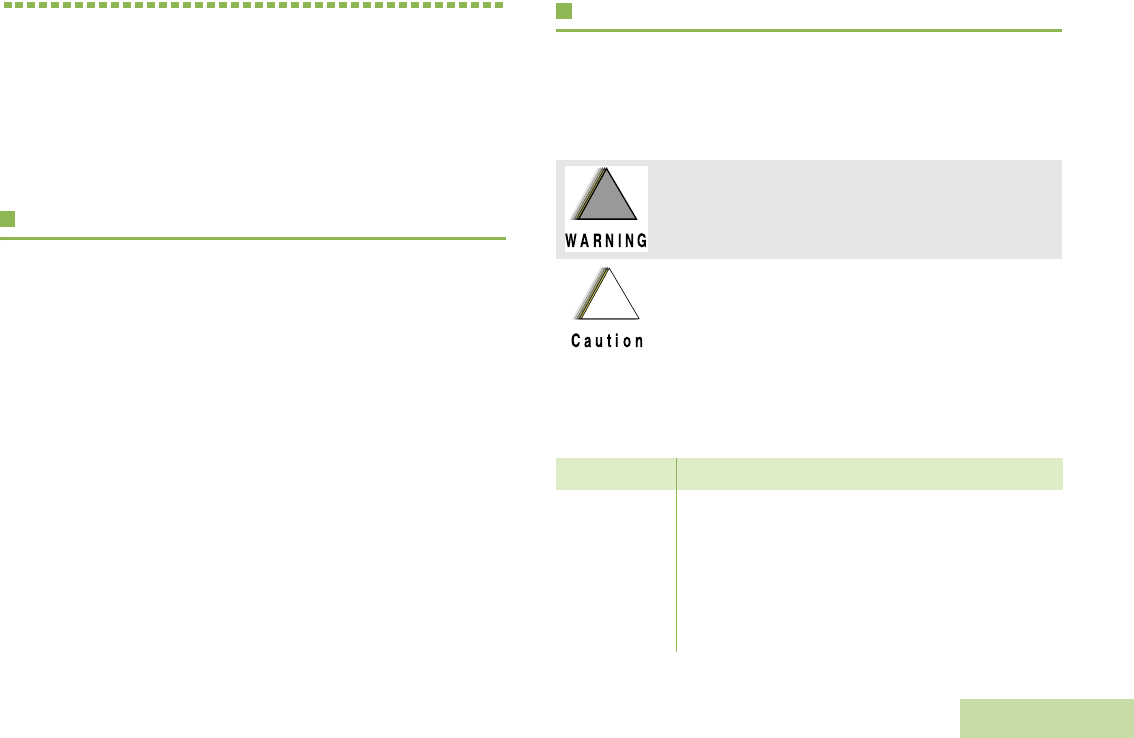
Getting Started
English
1
Getting Started
Take a moment to review the following:
How to Use This Guide . . . . . . . . . . . . . . . . . . . . . . . . . page 1
Notations Used in This Manual . . . . . . . . . . . . . . . . . . . page 1
What Your Dealer/System Administrator Can Tell You . page 2
How to Use This Guide
This User Guide covers the basic operation of the APX™ 7000
Portables.
However, your dealer or system administrator may have
customized your radio for your specific needs. Check with your
dealer or system administrator for more information.
Notations Used in This Manual
Throughout the text in this publication, you will notice the use of
WARNING, Caution, and Note. These notations are used to
emphasize that safety hazards exist, and the care that must be
taken or observed.
The following special notations identify certain items:
An operational procedure, practice, or condition,
etc., which may result in injury or death if not
carefully observed.
An operational procedure, practice, or condition,
etc., which may result in damage to the equipment
if not carefully observed.
Note: An operational procedure, practice, or condition,
etc., which is essential to emphasize.
Example Description
Home button
or HButtons and keys are shown in bold print or as
an icon.
Phone Menu entries are shown similar to the way they
appear on the radio’s display.
>This means “Press the right side of the 4-way
Navigation button.”
!!
!
6875945M01-A_Full.book Page 1 Tuesday, July 8, 2008 12:54 AM

Preparing Your Radio for Use
English
2
What Your Dealer/System Administrator
Can Tell You
You can consult your dealer or system administrator about the
following:
•Is your radio preprogrammed with any preset conventional
channels?
•Which buttons have been preprogrammed to access other
features?
•What optional accessories may suit your needs?
Preparing Your Radio for Use
Assemble your radio by following these steps:
Charging the Battery . . . . . . . . . . . . . . . . . . . . . . . . . . . page 2
Attaching the Battery . . . . . . . . . . . . . . . . . . . . . . . . . . . page 3
Attaching the Antenna . . . . . . . . . . . . . . . . . . . . . . . . . . page 4
Attaching the Belt Clip . . . . . . . . . . . . . . . . . . . . . . . . . . page 4
Attaching the Universal Connector Cover . . . . . . . . . . . page 5
Turning On the Radio. . . . . . . . . . . . . . . . . . . . . . . . . . . page 5
Adjusting the Volume. . . . . . . . . . . . . . . . . . . . . . . . . . . page 6
Charging the Battery
The Motorola-approved battery shipped with your radio is
uncharged. Prior to using a new battery, charge it for a minimum
of 16 hours to ensure optimum capacity and performance.
For a list of Motorola-authorized batteries available for use with
your radio, see Batteries and Battery Accessories on page
page 90.
To avoid a possible explosion:
•DO NOT replace the battery in any area labeled
“hazardous atmosphere”.
•DO NOT discard batteries in a fire.
!!
6875945M01-A_Full.book Page 2 Tuesday, July 8, 2008 12:54 AM
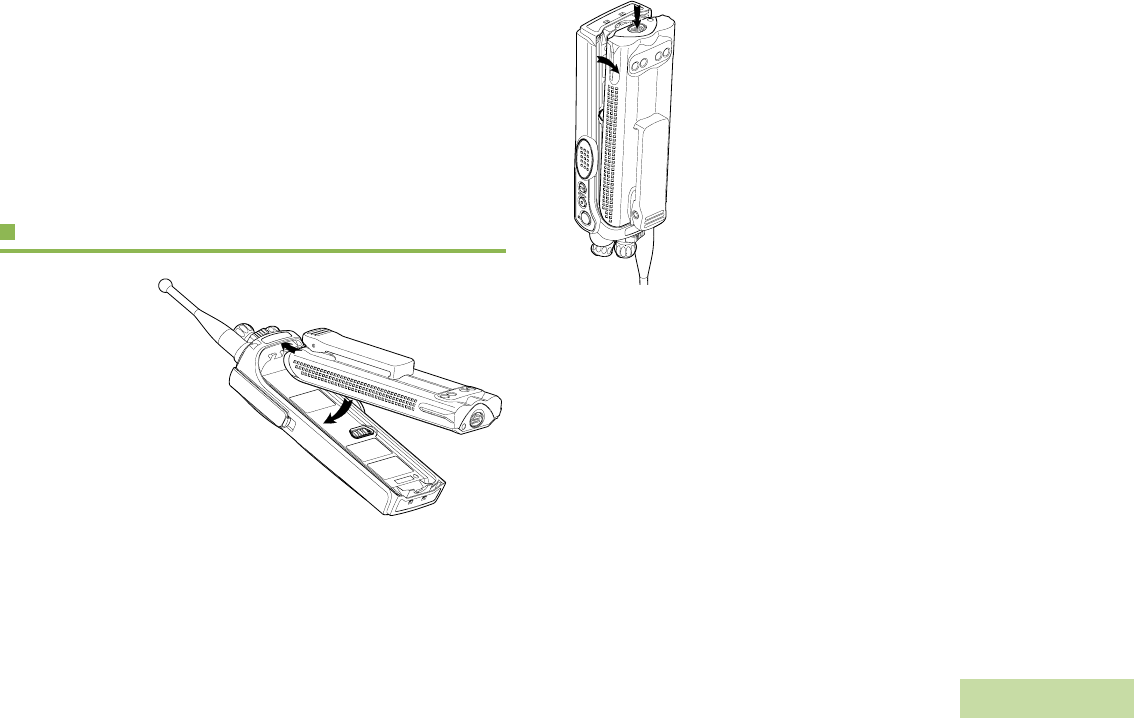
Preparing Your Radio for Use
English
3
Note: When charging a battery attached to a radio, turn the
radio off to ensure a full charge.
Battery Charger
To charge the battery, place the battery, with or without the
radio, in a Motorola-approved charger. The charger’s LED
indicates the charging progress; see your charger’s user guide.
For a list of chargers, see Chargers on page 91.
Attaching the Battery
With the radio
turned off, insert
the top edge of
the battery into
the radio’s frame.
Rotate the battery
toward the radio
and press down
until the battery
clicks into place.
To remove the battery, turn the radio
off. Press the release button on the
bottom of the battery until the battery
releases from the radio. Remove the
battery from the radio.
Note: If your radio is preprogrammed
with volatile-key retention,
encryption keys is retained for
approximately 30 seconds
after battery removal. Consult
your dealer for details.
Note: You can view the status of your Smart Battery. See
Accessing the Radio Information on page 82 for
more information.
Release Button
6875945M01-A_Full.book Page 3 Tuesday, July 8, 2008 12:54 AM
these diagrams will be replaced
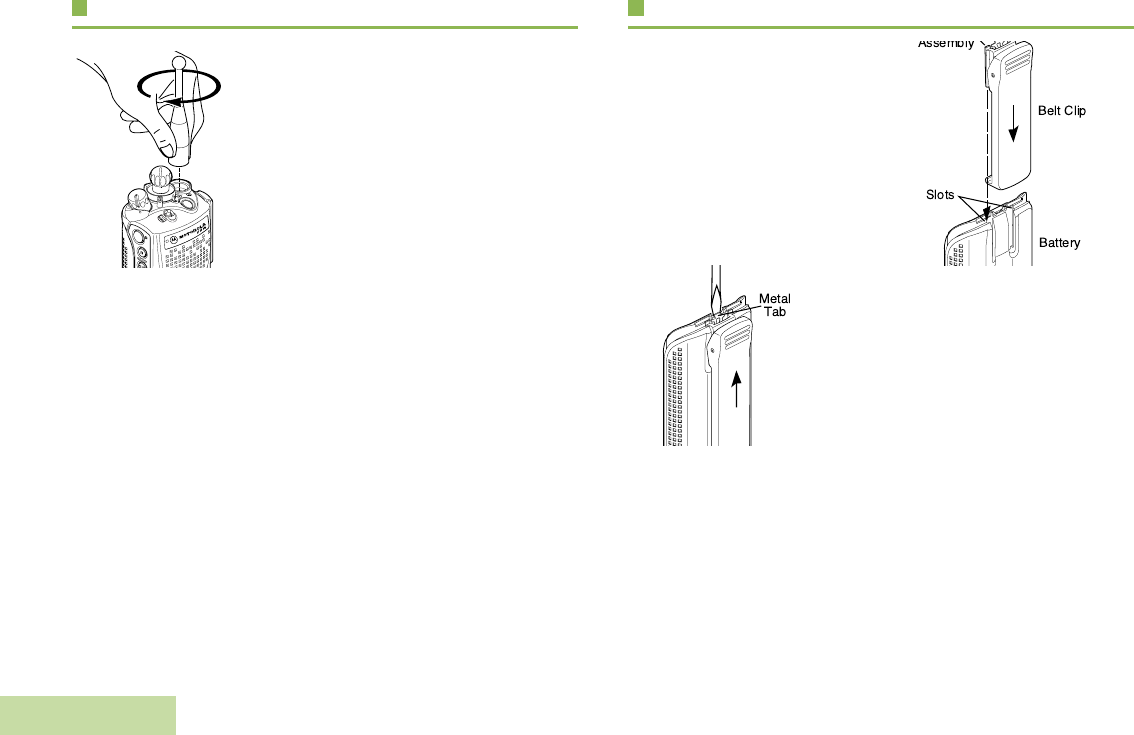
Preparing Your Radio for Use
English
4
Attaching the Antenna
With the radio turned off, set the antenna
in its receptacle and turn clockwise to
attach it to the radio.
To remove the antenna, turn the antenna
counterclockwise. Make sure you turn off
the radio first.
For information regarding available
antennas, see Antenna on page 88.
Attaching the Belt Clip
Align the grooves of the belt
clip with those of the battery
and press downward until
you hear a click.
To remove the clip, use a flat-bladed
object to press the belt clip tab away
from the battery. Then, slide the clip
upward and away from the radio.
6875945M01-A_Full.book Page 4 Tuesday, July 8, 2008 12:54 AM
these diagrams will be replaced
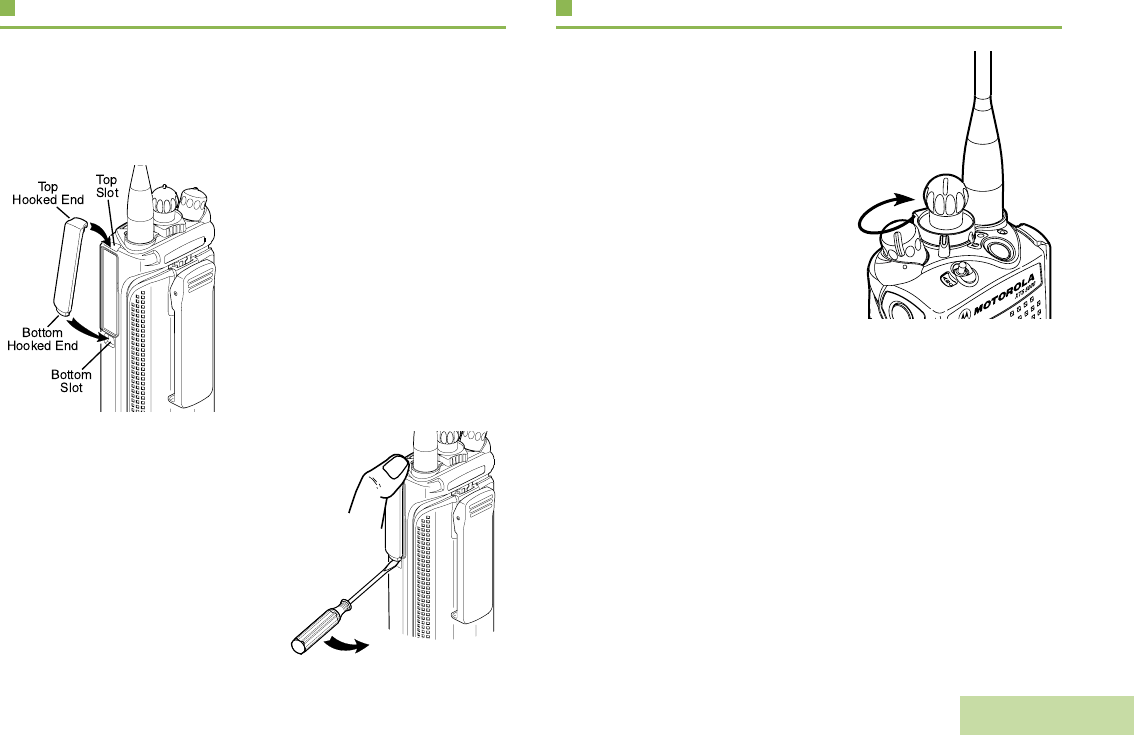
Preparing Your Radio for Use
English
5
Attaching the Universal Connector Cover
The universal connector is located on the antenna side of the
radio. It is used to connect accessories to the radio.
Note: To prevent damage to the connector, shield it with the
connector cover when not in use.
Insert the hooked end of the
cover into the slot above the
connector. Press downward on
the cover’s top to seat it in the
slot.
Rub the ball of your thumb from
the top to the bottom of the cover
while applying pressure towards
the radio. This should flex the
cover and snap it into place.
To remove the universal
connector cover, insert a flat-
bladed screwdriver into the area
between the bottom of the cover
and the slot below the connector.
Hold the top of the cover with
your thumb while you pry the
bottom of the cover away from
the radio with the screwdriver.
Turning On the Radio
Rotate the On/Off/
Volume Control
Knob clockwise until
you hear a click.
If the power-up test is
successful, you see
SELF TEST on the
radio’s display
momentarily, followed
by the home display.
Note: If the power-up test is unsuccessful, you see Error
XX/YY (XX/YY is an alphanumeric code).
Note: Turn off the radio, check the battery, and turn the radio
back on. If the radio fails the power-up test again,
record the Error XX/YY code and contact your dealer.
On
6875945M01-A_Full.book Page 5 Tuesday, July 8, 2008 12:54 AM
these diagrams will be replaced
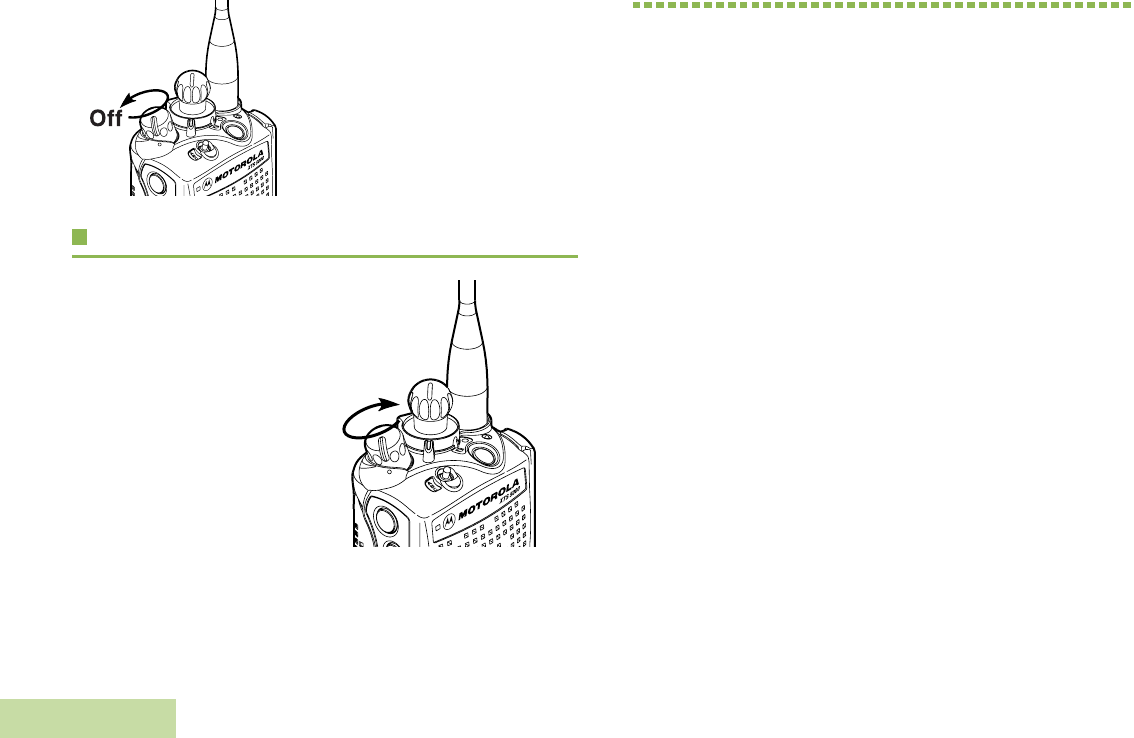
Identifying Radio Controls
English
6
To turn off the radio, rotate the
On/Off/Volume Control Knob
counterclockwise until you hear a
click.
Adjusting the Volume
To increase the
volume, turn the On/
Off/Volume Control
Knob clockwise.
To decrease the
volume, turn this knob
counterclockwise.
Identifying Radio Controls
Take a moment to review the following:
Radio Controls You Will Be Using . . . . . . . . . . . . . . . . . page 7
Programmable Features . . . . . . . . . . . . . . . . . . . . . . . . page 8
Accessing the Preprogrammed Functions. . . . . . . . . . page 10
Using the Keypad . . . . . . . . . . . . . . . . . . . . . . . . . . . . page 12
Push-To-Talk (PTT) Button . . . . . . . . . . . . . . . . . . . . . page 13
On
6875945M01-A_Full.book Page 6 Tuesday, July 8, 2008 12:54 AM
these diagrams will be replaced
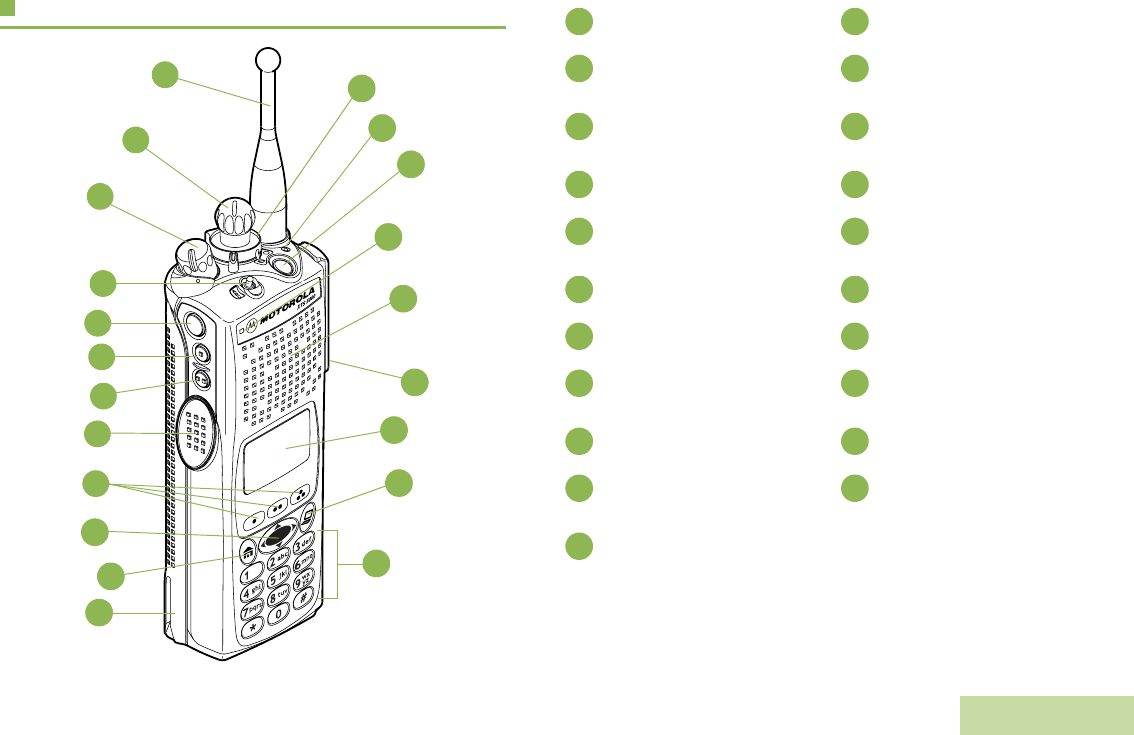
Identifying Radio Controls
English
7
Radio Controls You Will Be Using
1
2
3
4
5
6
7
8
9
10
11
12
13
14
19
18
17
16
15
21
20
Antenna Battery
16-Position Select
Knob* Keypad
On/Off/Volume Control
Knob Universal Connector
3-Position A/B/C Switch* Display
Top Side (Select)
Button* Universal Connector
Side Button 1* Speaker
Side Button 2* Microphone
Push-to-Talk (PTT)
Button Top Button*
Menu Select Buttons LED
4-Way Navigation Button 2-Position Concentric
Switch*
Home Button
* These radio controls/buttons are programmable to operate
certain software-activated features.
112
213
314
415
516
617
718
819
920
10 21
11
6875945M01-A_Full.book Page 7 Tuesday, July 8, 2008 12:54 AM
this diagram will be replaced

Identifying Radio Controls
English
8
Programmable Features
Any references in this manual to controls that are
“preprogrammed” mean that a qualified radio technician must
use the radio’s programming software to assign a feature to a
control.
Your dealer can program the programmable buttons or keypad
as shortcuts to radio functions or preset channels/groups
depending on the duration of a button press:
•Press – Pressing and releasing rapidly.
•Long press – Pressing and holding for the preprogrammed
duration (between 0.25 seconds and 3.75 seconds).
•Hold down – Keeping the button pressed.
Assignable Radio Functions
Call Alert – Allows the radio to function like a pager, or to verify
if a radio is active on the system.
Call Response – Allows you to answer a private call.
Channel – Selects a channel.
Dynamic Priority – Allows any channel in a scan list (except for
the priority-one channel) to temporarily replace the priority-two
channel.
Emergency – Depending on the programming, initiates or
cancels an emergency alarm or call.
Monitor – Monitors a selected channel for all radio traffic until
function is disabled.
Nuisance Delete – Temporarily removes an unwanted channel,
except for priority channels or the designated transmit channel,
from the scan list. The designated transmit channel refers to the
user’s selected zone/channel combination from which scan is
initiated.
Phone – Allows you to make and receive calls similar to
standard phone calls.
PL Defeat – Overrides any coded squelch (DPL or PL) that is
preprogrammed to a channel.
Private Call – Allows a call from an individual radio to another
individual radio.
Repeater/Direct – Toggles between using a repeater and
communicating directly with another radio.
Reprogram Request – Notifies the dispatcher that you want a
new dynamic regrouping assignment.
Scan List Programming – Selects the scan list for editing.
Scan On/Off – Toggles scan on or off.
6875945M01-A_Full.book Page 8 Tuesday, July 8, 2008 12:54 AM

Identifying Radio Controls
English
9
Secure/Clear – Toggles secure operation on or off
Select – Selects the assigned list for editing.
Selective Call – Calls an assigned radio.
Site Lock/Unlock – Locks onto a specific site.
Site Search – Displays the current site.
Status – Sends data calls to the dispatcher about a predefined
status.
Text Messaging – Selects the text messaging menu.
TMS Quick Text – Selects a predefined message.
User Login – Automatically registers with the server.
Zone – Allows selection from a list of zones.
Assignable Settings or Utility Functions
Keypad Mute – Toggles the keypad tones on or off.
Light – Toggles display backlight on or off.
Smart Battery – Displays the status of your Smart Battery.
TX Power Level – Toggles transmit power level between high
and low.
Volume Set – Sets the volume set tone.
6875945M01-A_Full.book Page 9 Tuesday, July 8, 2008 12:54 AM

Identifying Radio Controls
English
10
Accessing the Preprogrammed Functions
You can access various radio functions through one of the
following ways:
•A short or long press of the relevant programmable buttons.
OR
•Use the Menu Select Buttons ({, |, and }).
Accessing the Menu Entry Features
The bottom row of the display contains one to three menu
entries (also known as softkeys). The softkeys allow you to
select one of several menus to access the radio’s features.
The menu entries, as shown in the table below, are accessed
through the Menu Select buttons.
Menu
Entry Feature Page Menu
Entry Feature Page
Batt Smart Battery 82 Phon Phone 25
Call Private Call/
Selective Call 25/31 Prog Editing 35
Chan Channel
Selection 24 Pswd Password 68
Clck Time/Date 78 Pwr TX Power
Level 76
Dir Repeater/
Direct 28 Reky Rekey
Request 66
Eras Key
Zeroization 65 Rpgm Reprogram
Request 34
Key Key Selection 64 Scan Scan On/Off 43
Kset Keyset
Selection 64 Site Site Lock/
Unlock 75
Logf Radio Lock 68 Sts Status Call 33
Mute Keypad Mute 77 Tgrp Talkgroup
Call 32
Name Text Select 35 View View a List 39
Num Number
Select 35 Zone Zone
Selection 23
Page Call Alert
Page 46 Loc Location 71
TMS Text
Messaging 54 User User Login 51
Menu
Entry Feature Page Menu
Entry Feature Page
6875945M01-A_Full.book Page 10 Tuesday, July 8, 2008 12:54 AM
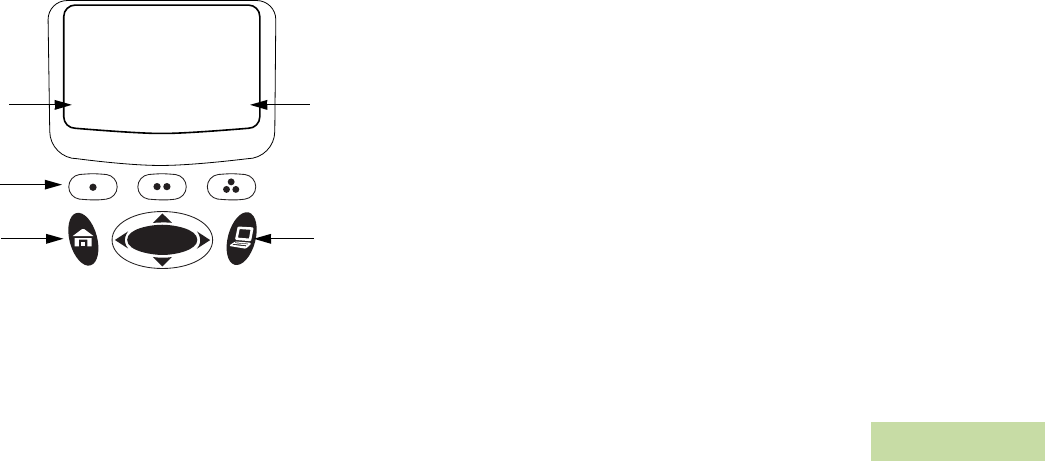
Identifying Radio Controls
English
11
Using the Menu Select Buttons
The Menu Select buttons ({, |, and }) access the menu
entries of features.
Note: Please check with a qualified radio technician for the
list of features activated in your radio.
Your radio may be preprogrammed differently from the following
example, but the display for turning Scan on or off may look as
shown below:
•To turn Scan on, press { directly below Sel.
Using the Navigation Buttons
Home Button
The H button always returns you to the home (default) display.
In most cases, this is the current mode.
Some radio features that you can edit require saving
information in memory. Press H after editing those features to
save the information before returning to the home display.
Note: Some features do not require you to press H to go to
the home display.
App Button (TMS Feature Button)
Use this button to access the Text Messaging Service (TMS)
feature screen.
4-Way Navigation Button
Use this button to scroll through the radio’s lists, or items in the
display, or both.
4-Way Navigation
Button
ON OFF
SCAN T
Menu Select
Buttons
menu entry
(Softkey)
App Button
Home
Button
menu entry
(Softkey)
(TMS Button)
6875945M01-A_Full.book Page 11 Tuesday, July 8, 2008 12:54 AM

Identifying Radio Controls
English
12
Using the Keypad
You can use the 3 x 4 alphanumeric keypad to access your radio’s features. The keypad functions in a manner similar to a standard
telephone keypad when entering numeric digits. When the keypad is used to edit a list, each key can generate different characters of
the alphabet. The table below shows the number of times a key needs to be pressed to generate the required character.
Keypad Characters
Number of Times Key is Pressed
Key1234567891011121314151617181920
11.,?! ;@_*#&$/+=\“ ‘()
2abc2ABC
3def 3DEF
4gh i 4GHI
5jkl5JKL
6mno6MNO
7pqr s7PQRS
8tuv8TUV
9wxyz9WXYZ
00Note: Press and hold to toggle between normal text entry mode and upper case mode.
*Space or *
#Press and hold to toggle between alphabetic mode and numeric mode.
6875945M01-A_Full.book Page 12 Tuesday, July 8, 2008 12:54 AM
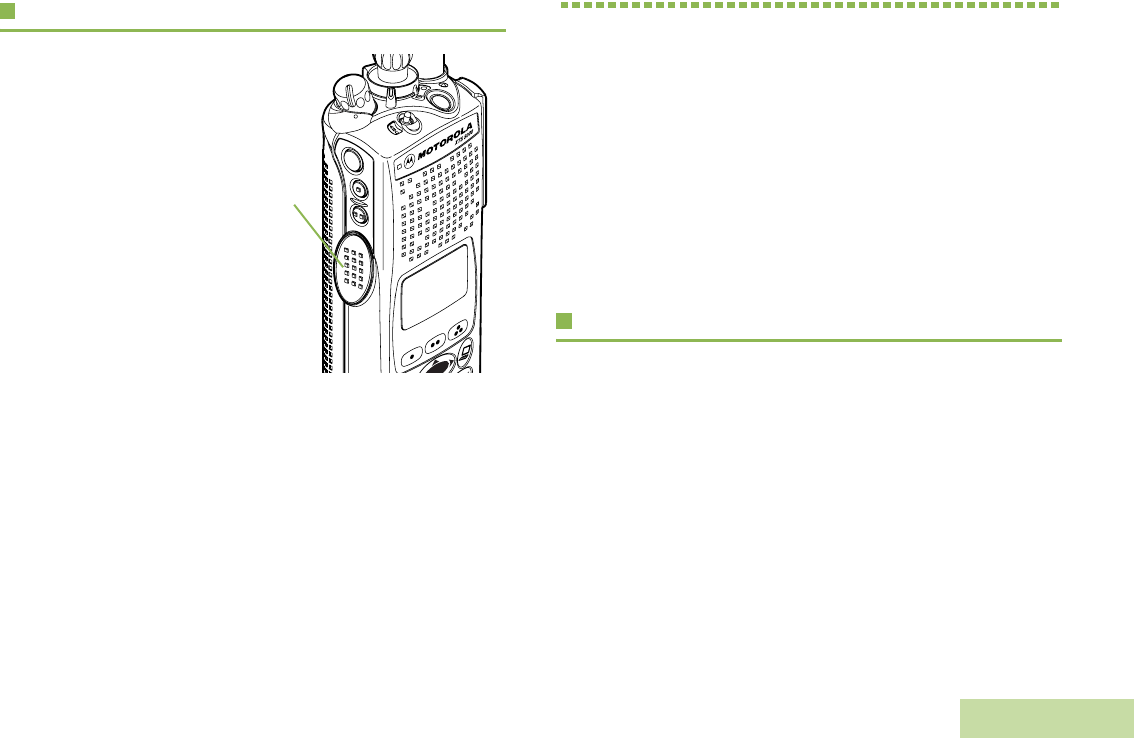
Identifying Status Indicators
English
13
Push-To-Talk (PTT) Button
The PTT button on the side
of the radio serves two basic
purposes:
•While a call is in progress,
the PTT button allows the
radio to transmit to other
radios in the call.
Press and hold down PTT
button to talk. Release the
PTT button to listen.
The microphone is
activated when the PTT
button is pressed.
•While a call is not in progress, the PTT button is used to make
a new call (see Making a Radio Call on page 26).
Identifying Status Indicators
Your radio indicates its operational status through the following:
Status Icons . . . . . . . . . . . . . . . . . . . . . . . . . . . . . . . . .page 13
Text Messaging Service (TMS) . . . . . . . . . . . . . . . . . .page 15
Status Icons . . . . . . . . . . . . . . . . . . . . . . . . . . . . . . .page 15
Menu Options . . . . . . . . . . . . . . . . . . . . . . . . . . . . . .page 16
LED Indicator . . . . . . . . . . . . . . . . . . . . . . . . . . . . . . . .page 17
Alert Tones . . . . . . . . . . . . . . . . . . . . . . . . . . . . . . . . . .page 19
Phone Call Display and Alert Prompts . . . . . . . . . . . . .page 22
Status Icons
The 64 x 96 pixel liquid crystal display (LCD) of your radio
shows radio status, text entries, and menu entries.
The top two display rows contain icons that indicate radio
operating conditions.
PTT
Button
Call Received
Radio receives an Individual Call.
Pending
image
6875945M01-A_Full.book Page 13 Tuesday, July 8, 2008 12:54 AM
this diagram will be replaced
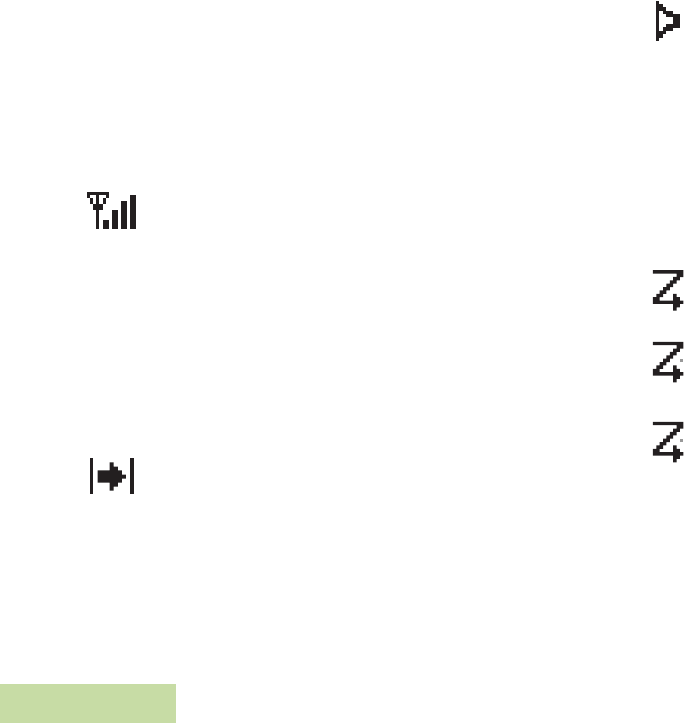
Identifying Status Indicators
English
14
View/Program Mode
Radio is in the view or program mode.
•On Steady = View mode
•Blinking = Program mode
Received Signal Strength Indicator (RSSI)
The number of bars displayed represents the
received signal strength for the current site, for
trunking only. The more stripes in the icon, the
stronger the signal.
Battery
•Conventional = Blinks when battery is low.
•Smart = The number of bars (0 – 4) shown
indicates the charge remaining in the
battery. Blinks when the battery is low.
Talkaround
•On = Radio is currently configured for direct radio
to radio communication (during conventional
operation only).
•Off = Radio is connected with other radios through
a repeater.
Pending
image
Pending
image
b
Monitor (Carrier Squelch)
Selected channel is being monitored (during
conventional operation only).
Secure Operation
•On = Secure operation
•Off = Clear operation
•Blinking = Receiving an encrypted voice call.
Scan
Radio is scanning a scan list.
Priority-One Channel Scan
A channel is assigned as the priority channel during
scan operation.
Priority-Two Channel Scan
Two channels are assigned as the priority channels
during scan operation.
Pending
image
Pending
image
6875945M01-A_Full.book Page 14 Tuesday, July 8, 2008 12:54 AM
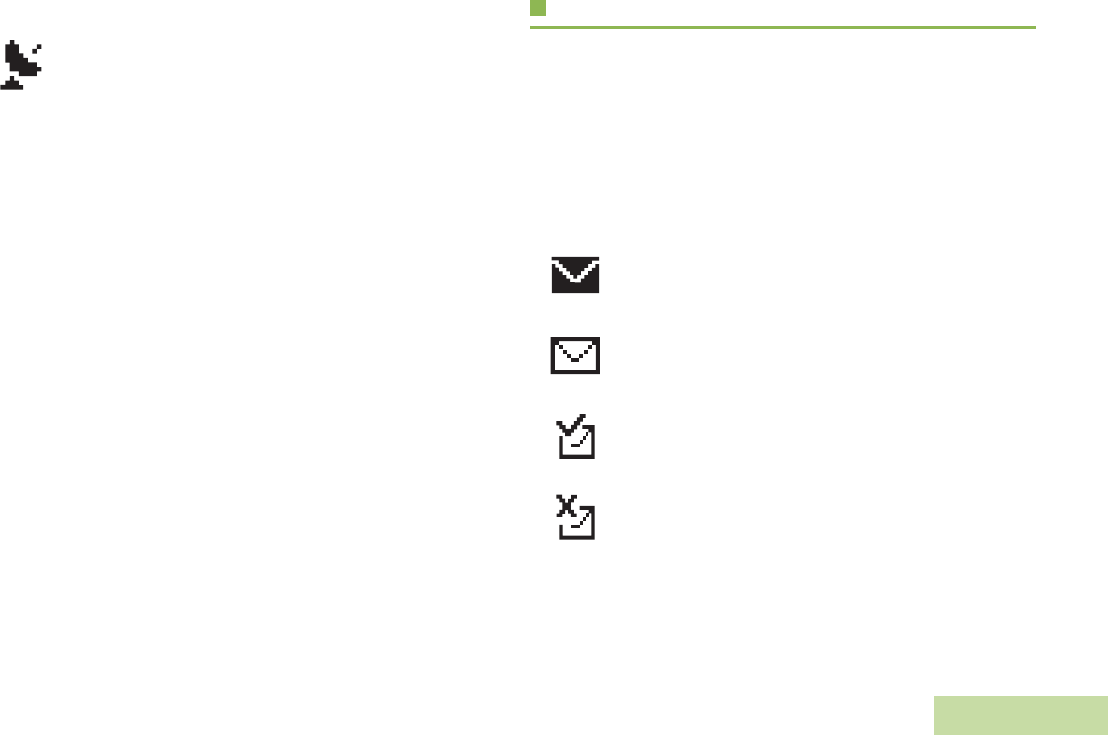
Identifying Status Indicators
English
15
Text Messaging Service (TMS)
This feature allows you to send and receive text messages. See
Text Messaging Service (TMS) on page 54 for more
information.
Status Icons
The following icons appear on the radio’s display when you
send and receive text messages.
Location Signal
•On = Location feature is enabled, and location
signal is available
•Off = Location feature is disabled, or there is
insufficient battery power in location
accessory device.
•Blinking = Location feature is enabled, but no
location signal is available.
User Login Indicator (IP Packet Data)
•On (Tinted) = User is currently associated with the
radio.
•Off (Not tinted) = User is currently not associated
with the radio.
•Blinking = Device registration or user registration
with the server failed due to an invalid
username or pin.
Pending
image
Pending
image
iP
iP
iP
Inbox Full
The Inbox is full.
New Message Icon
User receives a new message.
Message Sent
The text message is sent successfully.
Message Unsent
The text message cannot be sent.
Read Message
The selected text message in the Inbox has been
read.
Pending
image
6875945M01-A_Full.book Page 15 Tuesday, July 8, 2008 12:54 AM

Identifying Status Indicators
English
16
Menu Options
Unread Message
The selected text message in the Inbox has not been
read.
Message Index
Indicates the index of the current message the user
is viewing.
Example: If the user is looking at the third message
out of a total of 6 messages in the Inbox folder, the
icon is displayed as the icon on the left column.
Priority Message
•The “Priority” feature is toggled on before the
message is sent.
•Messages in the Inbox folder are flagged with
“Priority”.
Request Reply
•The “Request Reply” feature is toggled on before
the message is sent.
•Messages in the Inbox folder are flagged with
“Request Reply”.
Priority Message and Request Reply
•The “Priority” and “Request Reply” features are
toggled on before the message is sent.
•Messages in the Inbox folder are flagged with both
“Priority” and “Request Reply”.
Pending
image
Pending
image
Pending
image
Pending
image
Pending
image
Num Lock
Indicates that the text entry is currently in number
lock mode.
Normal Mode
Indicates that the text entry is currently in normal
mode.
Uppercase
Displayed during text editing mode to indicate that
the text entry is currently in uppercase mode.
Menu
Option Description/Function
Inbx
Stores new incoming messages or messages
that you have received. The Inbox can hold up
to 30 messages.
Comp Brings you to the compose screen.
Drft
Stores all saved messages or messages that
are to be sent at a later time. The Draft folder
can hold up to 10 messages.
Pending
image
Pending
image
Pending
image
6875945M01-A_Full.book Page 16 Tuesday, July 8, 2008 12:54 AM
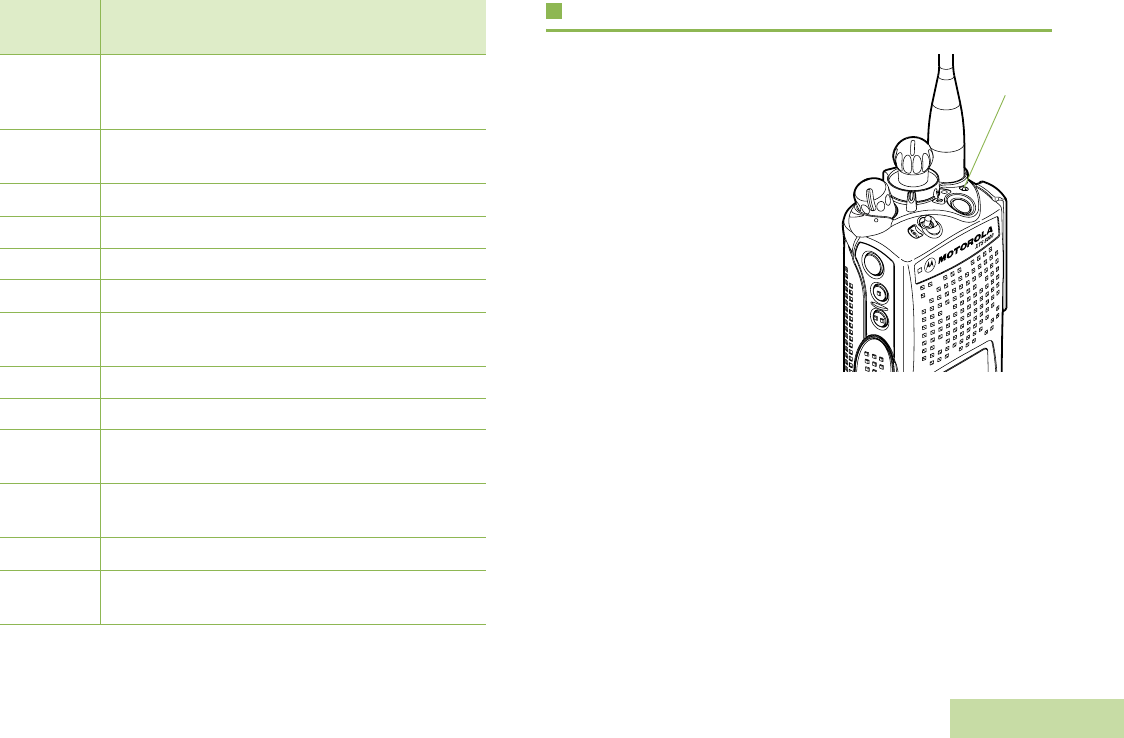
Identifying Status Indicators
English
17
LED Indicator
The LED indicator shows the
operational status of your radio.
Solid red – Radio is
transmitting.
Blinking red – Radio is
transmitting at low battery
condition.
Double blinking red – Radio is
transmitting or receiving an
emergency call.
Solid yellow – Channel is
busy.
Blinking yellow – Radio is receiving a secured transmission.
Solid green – Radio is powering up, or is scanning for activity.
Blinking green – Radio is receiving an individual call, or is
scanning a Priority-Two channel.
Double blinking green – Radio is scanning a Priority-One
channel.
Sent
Stores the messages that you have already
sent. The Sent folder can hold up to 10
messages.
Back Brings you back to the TMS main menu or
previous menu.
Edit Brings you to the Quick Text Messages screen.
Save Saves your messages to the Draft folder.
Rply Replies to a message.
Del Deletes a message.
Addr Keys in the target address, or selects one from
the list.
New Composes a new message.
List Selects a predefined message.
Impt Toggles on or off the “Priority” flag for an
outgoing message.
Rqrp Toggles on or off the “Request Reply” flag for
an outgoing message.
Curr Deletes the current selected message.
All Deletes all the messages in the current
message folder.
Menu
Option Description/Function
LED Indicator
6875945M01-A_Full.book Page 17 Tuesday, July 8, 2008 12:54 AM
this diagram will be replaced

Identifying Status Indicators
English
18
Intelligence Lighting Indicators
This feature temporary changes the radio’s display backlight and the alert text background color to help signal that a radio event has
occurred.
Note: This feature must be preprogrammed by a qualified radio technician.
Backlight and Bar Color Event When
Orange High Alert Event
The radio initiates an emergency alarm or call.
The radio receives an emergency alarm or call.
The Man Down timer expires.
Red System Status Events
The radio battery is low.
The radio is out of range.
The radio enters failsoft mode.
Green User Status Events
The radio receives a private call.
The radio receives a phone call.
The radio receives a call alert.
The radio receives a selective call.
6875945M01-A_Full.book Page 18 Tuesday, July 8, 2008 12:54 AM

Identifying Status Indicators
English
19
Alert Tones
An alert tone is a sound or group of sounds. Your radio uses alert tones to inform you of your radio’s conditions. The following table
lists these tones and when they occur.
You Hear Tone Name Heard
Short,
Low-Pitched Tone
Radio Self-Test Fail When radio fails its power-up self test.
Radio Self-Test Fail When radio fails its power-up self test.
Reject When unauthorized request is made.
Time-Out Timer Warning Four seconds before time out.
Long,
Low-Pitched Tone
No ACK Received When radio fails to receive an acknowledgment.
Time-Out Timer
Timed Out After time out.
Talk Prohibit/PTT Inhibit (When PTT button is pressed) transmissions are not allowed.
Out-of-Range (When PTT button is pressed) the radio is out of range of the system.
Invalid Mode When radio is on an unpreprogrammed channel.
Individual Call
Warning Tone When radio is in an individual call for greater than 6 seconds without any activity.
A Group of
Low-Pitched
Tones Busy When system is busy.
6875945M01-A_Full.book Page 19 Tuesday, July 8, 2008 12:54 AM

Identifying Status Indicators
English
20
Short,
Medium-Pitched
Tone
Valid Key-Press When correct key is pressed.
Radio Self-Test Pass When radio passes its power-up self test.
Clear Voice At beginning of a non-coded communication.
Priority Channel
Received When activity on a priority channel is received.
Emergency Alarm Entry When entering the emergency state.
Central Echo When central controller has received a request from a radio.
Long,
Medium-Pitched
Tone
Volume Set When volume is changed on a quiet channel.
Emergency Exit When exiting the emergency state.
A Group of
Medium-Pitched
Tones
Failsoft When the trunking system fails.
Automatic Call Back When voice channel is available from previous request.
Talk Permit (When PTT button is pressed) verifying system accepting transmissions.
Keyfail When encryption key has been lost.
Console Acknowledge When status, emergency alarm, or reprogram request ACK is received.
Received Individual Call When Call Alert or Private Call is received.
Call Alert Sent When Call Alert is received by the target radio.
You Hear Tone Name Heard
6875945M01-A_Full.book Page 20 Tuesday, July 8, 2008 12:54 AM

Identifying Status Indicators
English
21
Short,
High-Pitched
Tone (Chirp) Low-Battery Chirp When battery is below preset threshold value.
Short,
Medium-Pitched
Tone (Chirp)
GPS RSM Low
Battery Chirp When this accessory battery is below preset threshold value.
Momentary Low to
High Tone Latched PTT Active When Latched PTT state is engaged and before the radio transmits.
Momentary Tone Latched PTT Timeout When Latched PTT state is expiring. It sounds when the radio is transmitting and
replaces time-out timer warning tone in Latched PTT state.
Momentary High
to Low Tone Latched PTT Inactive When Latched PTT state is disengaged and after the radio completes
transmission.
Ringing
Fast Ringing When system is searching for target of Private Call.
Enhanced Call Sent When waiting for target of Private Call to answer the call.
Phone Call Received When a land-to-mobile phone call is received.
Gurgle Dynamic Regrouping (When the PTT button is pressed) a dynamic ID has been received.
Unique,
Low-Pitched
Chirp New Message When a new message is received.
Unique,
High-Pitched
Chirp Priority Message When a priority message is received.
You Hear Tone Name Heard
6875945M01-A_Full.book Page 21 Tuesday, July 8, 2008 12:54 AM

Identifying Status Indicators
English
22
Phone Call Display and Alert Prompts
The following appears on the radio’s display when you make and receive Phone calls. The radio also uses alert tones to indicate the
current status.
You Hear You See When Notes
A Long
Tone
No Phone You press the PTT button and the
phone system is not available. Press H to hang up. The radio returns to the home display.
Phone Busy The phone system is busy. Press H to exit the phone mode and try your call later.
A Busy
Tone Phone Busy When a channel is not available. The radio automatically connects when a channel opens.
–No
Acknowldg The call is not acknowledged. Press H to hang up. The radio returns to the home display.
A High-
Pitched
Tone –When you release the PTT button. The radio indicates to the landline party that he or she may begin
talking.
Note: You have the option of sending additional digits (overdial), such as an extension number, or credit card or PIN numbers, to the
phone system. If the radio is programmed for live overdial, every digit entered after the call is connected is sent to the phone
system.
If the radio is programmed for buffered overdial, the digits pressed are entered into memory and then sent when the PTT
button is pressed. Press the PTT button to send either digits or voice, but not both at the same time.
6875945M01-A_Full.book Page 22 Tuesday, July 8, 2008 12:54 AM
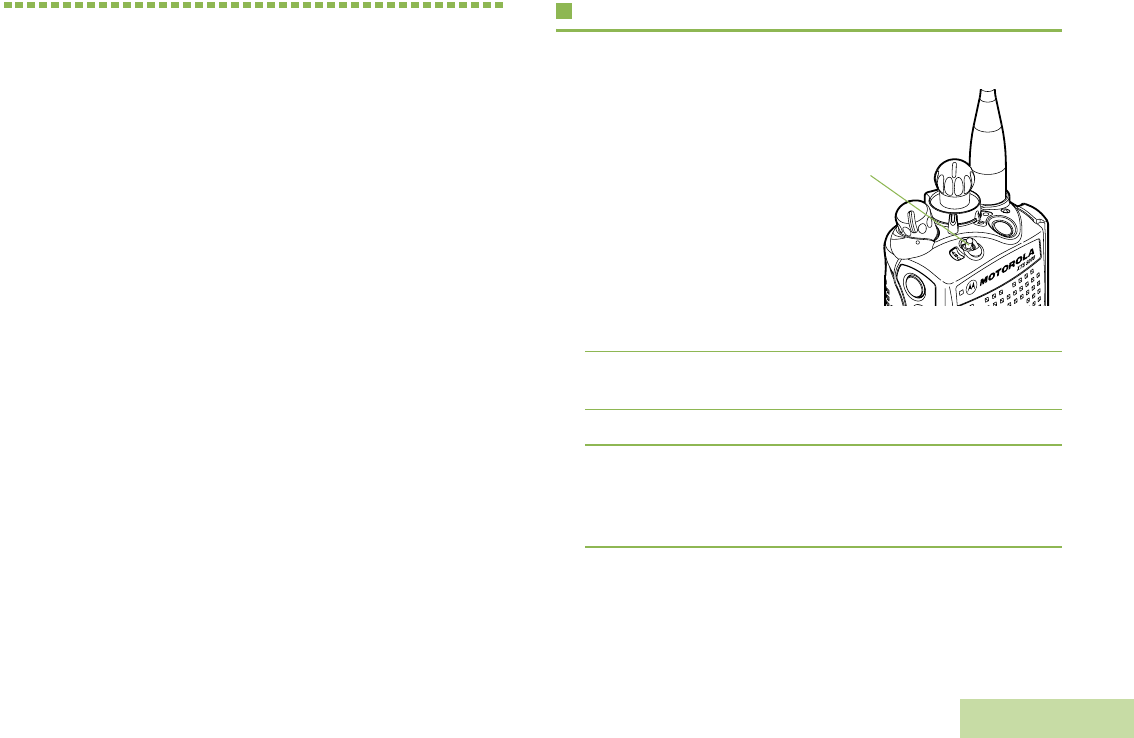
General Radio Operation
English
23
General Radio Operation
Once you understand how your APX 7000 Portable is
configured, you are ready to use your radio.
Use this navigation guide to familiarize yourself with the basic
Call features:
Selecting a Zone . . . . . . . . . . . . . . . . . . . . . . . . . . . . . page 23
Selecting a Radio Channel, Subscriber ID,
or Group ID . . . . . . . . . . . . . . . . . . . . . . . . . . . . . . . page 24
Receiving and Responding to a Radio Call. . . . . . . . . page 24
Making a Radio Call . . . . . . . . . . . . . . . . . . . . . . . . . . page 26
Repeater or Direct Operation . . . . . . . . . . . . . . . . . . . page 28
Monitoring Features. . . . . . . . . . . . . . . . . . . . . . . . . . . page 29
Selecting a Zone
A zone is a group of channels.
Use the following procedure
to select a zone.
Procedure:
Move the preprogrammed
Zone switch to the position of
the required zone and
proceed to step 3.
OR
Follow the procedure below.
1< or > to Zone.
2Press the Menu Select button directly below Zone. The
current zone blinks while the channel name remains steady.
3U or D to the required zone.
4Press the Menu Select button directly below Sel to confirm
the displayed zone and channel.
OR
Press the PTT button to transmit on the displayed zone.
3-Position
A/B/C Switch
6875945M01-A_Full.book Page 23 Tuesday, July 8, 2008 12:54 AM
this diagram will be replaced

General Radio Operation
English
24
Selecting a Radio Channel
A channel is a group of radio characteristics,
such as transmit/receive frequency pairs.
Use the following procedure to select a channel.
Note: Consult a qualified radio technician for
the right choice between the following
methods.
Procedure:
Turn the preprogrammed 16-Position Select knob to the
desired channel.
OR
Follow the procedure below.
1< or > to Chan.
2Press the Menu Select button directly below Chan. The
current channel name blinks while the zone remains steady.
3U or D to the required channel.
OR
Use the keypad to enter the channel number.
If the channel selected is unprogrammed, repeat Step 3.
4Press the Menu Select button directly below Sel to confirm
the displayed zone and channel.
OR
Press the PTT button to transmit on the displayed channel.
Receiving and Responding to a Radio Call
Once the channel, subscriber
ID or group ID is displayed,
you can proceed to receive
and respond to calls.
The LED lights up solid red
while the radio is transmitting
and blinks green when the
radio is receiving.
Receiving and Responding to a Talkgroup Call
To receive a call from a group of users, your radio must be
configured as part of that group.
Procedure:
When you receive a talkgroup call (while on the Home screen):
1The LED blinks green.
2The display shows the caller alias, the talkgroup alias, the
RSSI icon, and the Group Call icon.
3Hold the radio vertically 1 to 2 inches (2.5 to 5.0 cm) from
your mouth.
4Press the PTT button to respond to the call. The LED lights
up solid red.
Pending
image
LED Indicator
6875945M01-A_Full.book Page 24 Tuesday, July 8, 2008 12:54 AM
this diagram will be replaced

General Radio Operation
English
25
5Release the PTT button to listen.
6If there is no voice activity for a predetermined period of
time, the call ends.
See Making a Talkgroup Call on page 26 for details on making
a Talkgroup Call.
Receiving and Responding to a Private Call
(Trunking Only)
A Private Call is a call from an individual radio to another
individual radio.
These one-to-one calls between two radios are not heard by
others in the current talkgroup. The calling radio automatically
verifies that the receiving radio is active on the system and can
display the caller’s ID.
Note: The radio automatically exits the feature, if the time-out
timer is enabled, when the radio is left idle and time is
up. You will hear the Menu Inactive Exit Tone upon
feature exit.
Procedure:
Use the preprogrammed Call Response button to answer a
Private Call:
1You hear two alert tones and the LED blinks green. The
display shows Call Receivd and the call received icon
blinks.
2Press the Call Response button within 20 seconds after the
call indicators begin.
3During the call, the display shows the caller’s name, if it is in
the call list.
OR
During the call, the display shows the caller’s ID number, if
the caller’s name is not in the call list.
4Press and hold the PTT button to talk. Release the PTT
button to listen.
5Press H or the Call Response button to hang up and
return to the home display.
See Making a Private Call (Trunking Only) on page 27 for
details on making a Private Call.
Receiving and Responding to a Telephone Call
(Trunking Only)
This feature allows you to receive calls similar to standard
phone calls from a landline phone.
Note: The radio automatically exits the feature, if the time-out
timer is enabled, when the radio is left idle and time is
up. You will hear the Menu Inactive Exit Tone upon
feature exit.
6875945M01-A_Full.book Page 25 Tuesday, July 8, 2008 12:54 AM

General Radio Operation
English
26
Procedure:
Use the preprogrammed Call Response button to answer a
Telephone Call:
1You hear a telephone-type ringing and the LED blinks
green. The display shows Phone Call and the call received
icon blinks.
2Press the Call Response button within 20 seconds after the
call indicators begin.
3Press and hold the PTT button to talk. Release the PTT
button to listen.
4Press H or the Call Response button to hang up and
return to the home display.
See Making a Telephone Call (Trunking Only) on page 27 for
details on making a Telephone Call.
Making a Radio Call
You can select a channel, subscriber ID, or group by using:
•The Channel Selector Knob
•A preprogrammed One Touch Call button
•The Contacts list (see Viewing a Details of a Contact on
page 39)
Making a Talkgroup Call
To make a call to a group of users, your radio must be
configured as part of that group.
Procedure:
1Turn the Channel Selector Knob to select the channel with
the active group alias or ID.
2Hold the radio vertically 1 to 2 inches (2.5 to 5.0 cm) from
your mouth.
3Press the PTT button to make the call. The LED lights up
solid red. The display shows the group alias or ID, and the
Group Call icon.
4Speak clearly into the microphone.
5Release the PTT button to listen.When the target radio
responds, the LED blinks green. You see the Group Call
6875945M01-A_Full.book Page 26 Tuesday, July 8, 2008 12:54 AM

General Radio Operation
English
27
icon, the group alias or ID, and transmitting radio alias or ID
on your display.
6If there is no voice activity for a predetermined period of
time, the call ends.
7Radio returns to the previous screen you were on prior to
receiving the call.
Making a Private Call (Trunking Only)
Procedure:
Press the preprogrammed Quick Access (One-Touch) Private
Call button to dial the preprogrammed ID number and proceed
to Step 5 of the procedure below.
OR
Follow the procedure below.
1< or > to Call.
2Press the Menu Select button directly below Call. The
display shows the last transmitted or received ID number.
3Press Lnum to go to the last number dialed.
OR
U or D to the required ID number.
OR
Use the keypad to enter the required ID number.
4Press the PTT button to start the Private Call.
5The display momentarily shows Please Wait and the ID
number.
6Hold the radio vertically 1 to 2 inches (2.5 to 5.0 cm) from
your mouth.
7When you are connected, the display shows the ID number
of the target radio. Press and hold the PTT button to talk.
Release the PTT button to listen.
OR
If no acknowledgment is received, the display shows No
Acknowldg.
OR
If the target radio does not respond before the time out, the
display shows No Answer.
8Press H to hang up and return to the home display.
You can send an individual Call Alert page if there is no answer
from the target radio. See Sending a Call Alert Page on
page 46 for more information.
Making a Telephone Call (Trunking Only)
This feature allows you to make calls similar to standard phone
calls to a landline phone.
Procedure:
Press the preprogrammed Quick Access (One-Touch) Phone
Call button to dial the preprogrammed phone number and
proceed to Step 5 of the procedure below.
6875945M01-A_Full.book Page 27 Tuesday, July 8, 2008 12:54 AM

General Radio Operation
English
28
OR
Follow the procedure below.
1< or > to Phon.
2Press the Menu Select button directly below Phon. The
display shows the last transmitted phone number.
3Press Lnum to go to the last number dialed.
OR
U or D to the required phone number.
OR
Use the keypad to enter the required phone number.
4Press and release the PTT button to dial the phone number.
5Hold the radio vertically 1 to 2 inches (2.5 to 5.0 cm) from
your mouth.
6When your call is answered, press the PTT button to talk.
Release the PTT button to listen.
7Press H to hang up and return to the home display.
See Phone Call Display and Alert Prompts on page 22 for
more information if your call is NOT answered.
Repeater or Direct Operation
The REPEATER operation increases the radio’s range by
connecting with other radios through a repeater. The transmit
and receive frequencies are different.
The DIRECT or “talkaround operation” allows you to bypass the
repeater and connect directly to another radio. The transmit and
receive frequencies are the same.
Procedure:
Press the preprogrammed Repeater/Direct switch to toggle
between talkaround and repeater modes.
OR
Follow the procedure below.
1< or > to Dir.
2Press the Menu Select button directly below Dir. The
display momentarily shows the current radio setting.
3You see Repeater mode if the radio is currently in
Repeater mode.
OR
You see Direct mode and the Talkaround icon if the radio is
currently in Direct mode.
6875945M01-A_Full.book Page 28 Tuesday, July 8, 2008 12:54 AM

General Radio Operation
English
29
4Press the Menu Select button directly below Dir to enable
Direct mode. The display shows the Talkaround status icon.
OR
Press the Menu Select button directly below Rptr to enable
Repeater mode.
OR
Press H to exit without changing the current radio setting.
Monitoring Features
Radio users who switch from analog to digital radios often
assume that the lack of static on a digital channel is an
indication that the radio is not working properly. This is not the
case.
Digital technology quiets the transmission by removing the
“noise” from the signal and allowing only the clear voice or data
information to be heard.
Use the Monitor feature to make sure a channel is clear before
transmitting.
Monitoring a Channel
Procedure:
Use the preprogrammed Volume Set Button button.
1Select the desired zone and channel.
2Press and hold the Volume Set button to hear the volume
set tone.
3Adjust the Volume Control knob if necessary.
4Release the Volume Set button.
5Press and hold the PTT button to transmit. The LED lights
up solid red.
6Release the PTT button to receive (listen).
6875945M01-A_Full.book Page 29 Tuesday, July 8, 2008 12:54 AM

General Radio Operation
English
30
OR
Press the preprogrammed Monitor button and proceed to Step
3 of the procedure below.
OR
Follow the procedure below.
1Select the desired zone and channel.
2Listen for a transmission.
3Adjust the Volume Control knob if necessary.
4Press and hold the PTT button to transmit. The LED lights
up solid red.
5Release the PTT button to receive (listen).
The Carrier Squelch indicator appears on the display when you
monitor a channel via the preprogrammed Monitor button.
Conventional Mode Operation
Your radio may be preprogrammed to receive Private-Line®
(PL) calls.
Procedure:
1Momentarily press the Monitor button to listen for activity.
The Carrier Squelch indicator appears on the display.
2Press and hold the Monitor button to set continuous
monitor operation. The duration of the button press is
programmable.
3Press the Monitor button again, or the PTT button, to return
to the original squelch setting.
If you try to transmit on a receive-only channel, you hear an
invalid tone until you release the PTT button.
6875945M01-A_Full.book Page 30 Tuesday, July 8, 2008 12:54 AM

Advanced Features
English
31
Advanced Features
Use this navigation guide to learn more about advanced
features available with your radio:
Advanced Call Features . . . . . . . . . . . . . . . . . . . . . . . page 33
Contacts . . . . . . . . . . . . . . . . . . . . . . . . . . . . . . . . . . . page 35
Scan Lists . . . . . . . . . . . . . . . . . . . . . . . . . . . . . . . . . . page 40
Scan . . . . . . . . . . . . . . . . . . . . . . . . . . . . . . . . . . . . . . page 43
Call Alert Paging . . . . . . . . . . . . . . . . . . . . . . . . . . . . . page 45
Emergency Operation . . . . . . . . . . . . . . . . . . . . . . . . . page 47
Automatic Registration Service (ARS) User Login . . . page 54
Text Messaging Service (TMS) . . . . . . . . . . . . . . . . . . page 54
Secure Operations. . . . . . . . . . . . . . . . . . . . . . . . . . . . page 63
Security . . . . . . . . . . . . . . . . . . . . . . . . . . . . . . . . . . . . page 67
Global Positioning System (GPS) Enabled . . . . . . . . . page 69
Trunking System Controls . . . . . . . . . . . . . . . . . . . . . . page 74
Utilities. . . . . . . . . . . . . . . . . . . . . . . . . . . . . . . . . . . . . page 76
Advanced Call Features
Receiving and Making a Selective Call (ASTRO
Conventional Only)
This feature allows you to receive a call from or to call a select
individual. It is intended to provide privacy and to eliminate the
annoyance of having to listen to conversations that are of no
interest to you.
Receiving a Selective Call
Procedure:
1When you receive a Selective Call, you hear two alert tones
and the LED blinks green. The call received icons blinks and
the display shows Call Receivd.
2The display remains active for two seconds, and then the
speaker unmutes.
3Hold the radio vertically 1 to 2 inches (2.5 to 5.0 cm) from
your mouth.
4Press and hold the PTT button to talk. Release the PTT
button to listen.
5Press H to hang up and return to the home display.
6875945M01-A_Full.book Page 31 Tuesday, July 8, 2008 12:54 AM

Advanced Features
English
32
Making a Selective Call
Procedure:
Press the preprogrammed Quick Access (One-Touch)
Selective Call button to dial the preprogrammed ID number
and proceed to Step 5 of the procedure below.
OR
Follow the procedure below.
1< or > to Call.
2Press the Menu Select button directly below Phon. The
display shows the last transmitted or received ID number.
3Press Lnum to go to the last number dialed.
OR
U or D to the required ID number.
OR
Use the keypad to enter the required ID number.
4Press the PTT button to start the Selective Call.
5Hold the radio vertically 1 to 2 inches (2.5 to 5.0 cm) from
your mouth.
6When you are connected, the display shows the ID number
of the target radio. Press and hold the PTT button to talk.
Release the PTT button to listen.
7Press H to hang up and return to the home display.
Using the Talkgroup Call Feature (Conventional
Operation Only)
This feature allows you to define a group of conventional
system users so that they can share the use of a conventional
channel.
Note: Encryption keys are slaved to talkgroups. When
talkgroups are enabled, encryption keys are changed
by changing the active talkgroup. See Secure
Operations on page 63.
Selecting a Talkgroup
Procedure:
1< or > to Tgrp.
2Press the Menu Select button directly below Tgrp. The
display shows the last talkgroup that was selected and
stored, Sel and Pset.
3U or D to the required talkgroup.
OR
Use the keypad to enter the number of the corresponding
talkgroup in the list.
4Press the Menu Select button directly below Sel to save the
currently displayed talkgroup and return to the home
display.
OR
6875945M01-A_Full.book Page 32 Tuesday, July 8, 2008 12:54 AM

Advanced Features
English
33
Press the Menu Select button directly below Pset to select
the preset preprogrammed talkgroup.
5If the encryption key slaved to the new talkgroup is erased,
a momentary key fail tone sounds and the display shows
Key fail.
OR
If the encryption key that is slaved to the new talkgroup is
not allowed, a momentary key fail tone sounds and the
display shows Illegal Key.
6Press H or the PTT button to exit.
OR
Turn the 16-Position Select knob to exit.
Sending a Status Call (ASTRO 25 Trunking Only)
This feature allows you to send data calls to the dispatcher
about a predefined status.
Note: Each status can have up to a 12-character name. A
maximum of eight status conditions is possible.
Procedure:
Press the preprogrammed Status button and proceed to Step 3
of the procedure below.
OR
Follow the procedure below.
1< or > to Sts.
2Press the Menu Select button directly below Sts.
3The display shows the last acknowledged status call, or the
first status in the list.
4U or D to the required status.
OR
Use the keypad to enter a number corresponding to the
location in the status list.
5Press the PTT button to send the status.
6When the dispatcher acknowledges, four tones sound and
the display shows Ack Received. The radio returns to
normal dispatch operation.
OR
If no acknowledgment is received, a low-pitched tone
sounds and the display shows No Acknowldg.
7Press H to return to the home display.
No traffic is heard on trunked channels while Status Calls is
selected.
If the radio detects no Status Call activity for six seconds, an
alert tone sounds until you press H or the PTT button.
Using the Dynamic Regrouping Feature (Trunking
Only)
This feature allows the dispatcher to temporarily reassign
selected radios to a single special channel so they can
communicate with each other. This feature is typically used
6875945M01-A_Full.book Page 33 Tuesday, July 8, 2008 12:54 AM

Advanced Features
English
34
during special operations and is enabled by a qualified radio
technician.
You will not notice whether your radio has this feature enabled
until a dynamic regrouping command is sent by the dispatcher.
Note: If you try to access a zone or channel that has been
reserved by the dispatcher as a dynamically regrouped
mode for other users, an invalid tone sounds.
Procedure:
1When your radio is dynamically regrouped, it automatically
switches to the dynamically regrouped channel. A “gurgle”
tone sounds and the display shows the dynamically
regrouped channel’s name.
2Press the PTT button to talk. Release PTT button to listen.
When the dispatcher cancels dynamic regrouping, the radio
automatically returns to the zone and channel that you were
using before the radio was dynamically regrouped.
Requesting a Reprogram (ASTRO 25 Trunking Only)
This feature lets you notify the dispatcher that you want a new
dynamic regrouping assignment.
Procedure:
Press the preprogrammed Reprogram Request button to send
reprogram request to the dispatcher and proceed to Step 3 of
the procedure below.
OR
Follow the procedure below.
1< or > to Rpgm.
2Press the Menu Select button directly below Rpgm to send
reprogram request to the dispatcher.
3The display shows Reprgrm rqst.
4If you hear one beep:
Press the PTT button to send the reprogram request again
or press H to cancel and return to the home display.
OR
If you hear five beeps, the dispatcher has acknowledged the
reprogram request. Your radio returns to the home display.
OR
If the dispatcher does not acknowledge the reprogram
request within six seconds, a low-pitched alert tone sounds
and the display shows No Acknowldg.
Try again or press H to cancel and return to the home
display.
Classifying Regrouped Radios
The dispatcher can classify regrouped radios into either of two
categories: Select Enabled or Select Disabled.
•Select-enabled radios are free to change to any available
channel, including the dynamic-regrouping channel, once the
user has selected the dynamic-regrouping position.
6875945M01-A_Full.book Page 34 Tuesday, July 8, 2008 12:54 AM

Advanced Features
English
35
•Select-disabled radios cannot change channels while
dynamically regrouped. The dispatcher has forced the radio
to remain on the dynamic-regrouping channel.
The Scan or Private Call feature cannot be selected while your
radio is Select Disabled.
Contacts
This feature provides “address-book” capabilities on your radio.
Each entry corresponds to an alias (name) or ID (number) that
you use to initiate a call.
Contacts manages up to 10,000 contact entries, alphabetically
sorted according to entry alias or ID.
Note: Your radio must be programmed to allow you add, edit,
or delete the contact entries.
It also supports a maximum of 50 call lists. Each list can store
up to 100 contact aliases. Each alias can have up to 10 IDs of
different call types associated with it.
Note: Your radio is preprogrammed with a number of
contacts per Call Lists. Check with your dealer or
system administrator for more information.
Additionally, each entry, depending on context (conventional,
trucking, or phone), associates with one of four types of calls:
Phone Call, Selective Call, Private Call, or Call Alert.
Each entry within Contacts displays the following information:
•Call Alias (Name)
•Call ID (Number)
•Call Type (Icon)
Note: The radio automatically exits the feature, if the time-out
timer is enabled, when the radio is left idle and time is
6875945M01-A_Full.book Page 35 Tuesday, July 8, 2008 12:54 AM

Advanced Features
English
36
up. You will hear the Menu Inactive Exit Tone upon
feature exit.
Making a Private Call from Contacts
Procedure:
Use the Options Menu.
1< or > to Cnts.
2Press the Menu Select button directly below Cnts. The
entries are alphabetically sorted.
3U or D to the required subscriber alias or ID.
4Press the Menu Select button directly below Optn.
5U or D to Call and press the Menu Select button directly
below Sel.
6U or D to select the call type.
7Hold the radio vertically 1 to 2 inches (2.5 to 5.0 cm) from
your mouth.
8Press the PTT button to initiate the call.
9During the call, the display shows the subscriber alias, if it is
in the call list.
OR
During the call, the display shows the subscriber ID, if the
caller’s name is not in the call list.
10 Press and hold the PTT button to talk. Release the PTT
button to listen. The LED lights up solid green.
11 If there is no voice activity for a programmed period of time,
the call ends.
OR
The call ends when it reaches the maximum ring time.
OR
Use the PTT button.
1< or > to Cnts.
2Press the Menu Select button directly below Cnts. The
entries are alphabetically sorted.
3U or D to the required subscriber alias or ID.
4Hold the radio vertically 1 to 2 inches (2.5 to 5.0 cm) from
your mouth.
5Press the PTT button to initiate the call.
6During the call, the display shows the subscriber alias, if it is
in the call list.
OR
During the call, the display shows the subscriber ID, if the
caller’s name is not in the call list.
7Press and hold the PTT button to talk. Release the PTT
button to listen. The LED lights up solid green.
6875945M01-A_Full.book Page 36 Tuesday, July 8, 2008 12:54 AM

Advanced Features
English
37
8If there is no voice activity for a programmed period of time,
the call ends.
OR
The call ends when it reaches the maximum ring time.
Adding a New Contact Entry
Procedure:
1< or > to Cnts.
2Press the Menu Select button directly below Cnts. The
entries are alphabetically sorted.
3U or D to New Contact and press the Menu Select
button directly below Sel.
4U or D to New Name and press the Menu Select button
directly below Edit.
5You see Please enter a name and a blinking cursor
appears.
Use the keypad to enter the name.
Press < to move one space to the left.
Press > to move one space to the right.
Press Menu Select button directly below Del to delete any
unwanted characters.
Press and hold 0 to toggle between normal text entry
mode, uppercase mode and num lock mode.
6Press the Menu Select button directly below Done once you
have entered the name.
7Repeat Steps 4 through 6 to enter the ID and call type.
8Press the Menu Select button directly below Done once you
have finished entering the information.
9You see <Entry> Stored, confirming that the contact entry
has been added.
Deleting a Contact Entry
Procedure:
1< or > to Cnts.
2Press the Menu Select button directly below Cnts. The
entries are alphabetically sorted.
3U or D to the entry you want to delete and press the Menu
Select button directly below Optn.
4U or D to Delete and press the Menu Select button
directly below Sel.
5You see Deleting <Entry> Confirmed? on the display.
6Select Yes to delete the entry.
You see <Entry> deleted and the radio returns to the
main screen for Contacts.
OR
Select No to return to the main screen for Contacts.
6875945M01-A_Full.book Page 37 Tuesday, July 8, 2008 12:54 AM

Advanced Features
English
38
Adding a Contact to a Call List
Procedure:
1< or > to Cnts.
2Press the Menu Select button directly below Cnts. The
entries are alphabetically sorted.
3U or D to the entry you want to add to the call list and
press the Menu Select button directly below Optn.
4U or D to Add to Call List and press the Menu Select
button directly below Sel.
5You see <Entry> Added to Call List, confirming the
addition of the contact to the list.
6The radio returns to the main display for Contacts.
Editing a Contact in a Call List
Editing an Entry Alias
Procedure:
1< or > to Cnts.
2Press the Menu Select button directly below Cnts. The
entries are alphabetically sorted.
3U or D to the entry you want to edit and press the Menu
Select button directly below Optn.
4U or D to Edit and press the Menu Select button directly
below Sel.
5U or D to the entry alias you wish to change and press the
Menu Select button directly below Edit.
6A blinking cursor appears.
Use the keypad to edit the name.
Press < to move one space to the left.
Press > to move one space to the right.
Press Menu Select button directly below Del to delete any
unwanted characters.
Press and hold 0 to toggle between normal text entry
mode, uppercase mode and num lock mode.
7Press the Menu Select button directly below OK once you
have finished. The display returns to the Edit Contact
screen.
8Press the Menu Select button directly below Done to save
your changes and return to the main screen for Contacts.
Editing as Entry ID
Procedure:
1< or > to Cnts.
2Press the Menu Select button directly below Cnts. The
entries are alphabetically sorted.
6875945M01-A_Full.book Page 38 Tuesday, July 8, 2008 12:54 AM

Advanced Features
English
39
3U or D to the entry you want to edit and press the Menu
Select button directly below Optn.
4U or D to Edit and press the Menu Select button directly
below Sel.
5U or D to the entry ID you wish to change and press the
Menu Select button directly below Edit.
6A blinking cursor appears.
Use the keypad to edit the number.
Press < to move one space to the left.
Press > to move one space to the right.
Press Menu Select button directly below Del to delete any
unwanted characters.
Press and hold 0 to toggle between normal text entry
mode, uppercase mode and num lock mode.
7Press the Menu Select button directly below OK once you
have finished. The display returns to the Edit Contact
screen.
8Press the Menu Select button directly below Done to save
your changes and return to the main screen for Contacts.
Editing a Call Type
Procedure:
1< or > to Cnts.
2Press the Menu Select button directly below Cnts. The
entries are alphabetically sorted.
3U or D to the entry you want to edit and press the Menu
Select button directly below Optn.
4U or D to Edit and press the Menu Select button directly
below Sel.
5U or D to Type and press the Menu Select button directly
below Edit.
6U or D to choose from the list of call types given and
press the Menu Select button directly below OK to select.
7The display returns to the Edit Contact screen.
8Press the Menu Select button directly below Done to save
your changes and return to the main screen for Contacts.
Viewing a Details of a Contact
Procedure:
1< or > to Cnts.
2Press the Menu Select button directly below Cnts. The
entries are alphabetically sorted.
3U or D to the entry you want to view and press the Menu
Select button directly below Optn.
6875945M01-A_Full.book Page 39 Tuesday, July 8, 2008 12:54 AM

Advanced Features
English
40
4U or D to View Contact and press the Menu Select
button directly below Sel.
5You see all the numbers associated with the entry.
6U or D to select the number and press the Menu Select
button directly below Call make the call.
OR
Press Exit or H to return to the home display.
Scan Lists
Scan lists are created and assigned to individual channels/
groups. Your radio scans for voice activity by cycling through
the channel/group sequence specified in the scan list for the
current channel/group.
Your radio can support up to 32 different scan lists. These lists
must be preprogrammed by a qualified radio technician.
Viewing a Scan List
Procedure:
1< or > to View.
2Press the Menu Select button directly below View.
3U or D to view the available lists.
4Press the Menu Select button directly below the name of the
list you wish to view. The display shows the View mode icon
and the first list member.
5U or D to view other list members.
6Press H to exit the current display and return to the home
display.
If you wish to view a scan list and the list has no entries, you
see
EMPTY LIST
. To end this display, turn scan off or edit the
list.
6875945M01-A_Full.book Page 40 Tuesday, July 8, 2008 12:54 AM

Advanced Features
English
41
Editing the Scan List
This feature lets you change scan list members and priorities.
Note: The maximum number of members for a trunking
priority monitor scan list is 15; for a conventional scan
list, 15; and for a talkgroup scan list, 10.
Procedure:
Use the preprogrammed Select (Top Side) button.
1< or > to Prog.
2Press the Menu Select button directly below Prog. The
display shows the lists that can be changed.
3U or D to Scan.
4Press the Menu Select button directly below Scan.
5The display shows the programming mode icon and the first
list member.
6U or D to the number you want to edit.
7Press the Select button once to add the currently displayed
channel to the scan list.
8U or D to select more list members whose scan status
you want to change.
OR
Use the keypad to go directly to that scan list member.
OR
Use the 16-Position Select knob to select another scan list
member.
9Press H to exit scan list programming and return to the
home display.
OR
Move the preprogrammed Scan List Programming switch to
programming position and proceed to Step 5 of the procedure
below.
OR
Follow the procedure below.
1< or > to Prog.
2Press the Menu Select button directly below Prog. The
display shows the lists that can be changed.
3U or D to Scan.
4Press the Menu Select button directly below Scan.
5The display shows the programming mode icon and the first
list member.
6U or D to the number you want to edit.
7Press the Menu Select button directly below Sel to add and/
or change the priority of the currently displayed channel in
the scan list.
OR
Press the Menu Select button directly below Del to delete
6875945M01-A_Full.book Page 41 Tuesday, July 8, 2008 12:54 AM

Advanced Features
English
42
the currently displayed channel from the scan list.
OR
Press the Menu Select button directly below Rcl to view the
next member of the scan list.
8U or D to select more channels to be added or deleted.
OR
Use the keypad to go directly to additional channels to be
added or deleted.
OR
Use the 16-Position Select knob to select additional
channels to be added or deleted.
9Move the Scan List Programming switch out of
programming position.
OR
Press H to exit scan list programming and return to the
home display.
See Viewing and Changing the Priority Status on page 42
for more details on how to add and/or change the priority of the
currently displayed channel in the scan list.
Changing the Scan List Status
Procedure:
1Move the preprogrammed Scan List Programming switch
to programming position.
2The display shows the programming mode icon and the first
list member.
3U or D to the number you want to edit.
4Press the Select button once to add the currently displayed
channel to the scan list.
OR
Press the Select button one or more times to change the
scan list status icon of the currently displayed channel.
5U or D to select more list members whose scan status
you want to change.
OR
Use the keypad to go directly to that scan list member.
OR
Use the 16-Position Select knob to select another scan list
member.
6Move the Scan List Programming switch out of
programming position.
Viewing and Changing the Priority Status
Procedure:
1At the below Sel, Del, and Rcl screen, press the Menu
Select button directly below Sel to view and/or change the
priority status of the currently displayed channel.
OR
At the below Sel, Del, and Rcl screen, press the Select
6875945M01-A_Full.book Page 42 Tuesday, July 8, 2008 12:54 AM

Advanced Features
English
43
button one or more times to view and/or change the scan list
status icon of the currently displayed channel.
2A Scan icon indicates that the current channel is in the scan
list as a non-priority channel.
OR
A Priority-Two Channel Scan icon indicates that the current
channel is in the scan list as the priority 2 channel.
OR
A Priority-One Channel Scan icon indicates that the current
channel is in the scan list as the priority 1 channel. You hear
all traffic on the priority 1 channel, regardless of traffic on
non-priority channels.
OR
No icon indicates that the current channel is deleted from
the scan list.
You cannot delete a priority channel from a scan list. In a
talkgroup scan list, priority cannot be assigned.
Scan
This feature allows you to monitor traffic on different channels
by scanning a preprogrammed list of channels.
Turning Scan On or Off
Procedure:
Press the preprogrammed Scan button, or turn the
preprogrammed Scan switch to the Scan On or Scan Off
position, to start or stop Scan.
OR
Follow the procedure below.
1< or > to Scan.
2Press the Menu Select button directly below Scan. The
display shows the current radio setting.
3The display shows Scan Off if scan is disabled. Press the
Menu Select button directly below On to enable scan.
OR
The display shows Scan On and the scan status icon if scan
is enabled. Press the Menu Select button directly below Off
to disable scan.
6875945M01-A_Full.book Page 43 Tuesday, July 8, 2008 12:54 AM

Advanced Features
English
44
Making a Dynamic Priority Change (Conventional
Scan Only)
While the radio is scanning, the dynamic priority change feature
allows you to temporarily change any channel in a scan list
(except for the priority-one channel) to the priority-two channel.
The replaced (old) priority-two channel then becomes a non-
priority channel. This change remains in effect until scan is
turned off. Scan then reverts to the preprogrammed state.
Procedure:
1When the radio locks onto the channel designated as the
new priority-two channel, press the preprogrammed
Dynamic Priority button.
2The radio continues scanning the remaining channels in the
list.
To resume scanning the preprogrammed priority-two channel,
you must leave and re-enter scan operation.
Deleting a Nuisance Channel
If a channel continually generates unwanted calls or noise
(termed a “nuisance” channel), you can temporarily remove the
unwanted channel from the scan list.
This capability does not apply to priority channels or the
designated transmit channel.
Note: Deleting a “nuisance” channel is only possible through
the preprogrammed Nuisance Channel Delete
button. This feature is not accessible through the
menu.
Procedure:
1When the radio is locked onto the channel to be deleted,
press the preprogrammed Nuisance Delete button.
2The radio continues scanning the remaining channels in the
list.
Restoring a Nuisance Channel
Procedure:
To restore the deleted nuisance channel, do one of the
following:
•Turn the radio off and then turning it on again.
OR
•Stop and restart a scan via the preprogrammed Scan button
or menu.
6875945M01-A_Full.book Page 44 Tuesday, July 8, 2008 12:54 AM

Advanced Features
English
45
OR
•Change the channel via the 16-Position Select knob.
Call Alert Paging
This feature allows your radio to work like a pager.
Even if other users are away from their radios, or if they are
unable to hear their radios, you can send them an individual
Call Alert page. You can also verify if a radio is active on the
system.
Depending on how your radio is programmed, the radio either
automatically sends a call alert page if there is no answer after
the maximum ring time, OR when you press the PTT button.
Note: This feature must be preprogrammed by a qualified
radio technician.
Receiving and Answering a Call Alert
Procedure:
1When you receive a Call Alert page, you hear four repeating
alert tones and the LED blinks green. The call received
icons blinks and the display shows Page Receivd.
2Hold the radio vertically 1 to 2 inches (2.5 to 5.0 cm) from
your mouth.
3Press and hold the PTT button to talk. Release the PTT
button to listen.
6875945M01-A_Full.book Page 45 Tuesday, July 8, 2008 12:54 AM

Advanced Features
English
46
Sending a Call Alert Page
Note: The radio automatically exits the feature, if the time-out
timer is enabled, when the radio is left idle and time is
up. You will hear the Menu Inactive Exit Tone upon
feature exit.
Procedure:
Press the preprogrammed Quick Access (One-Touch) Call
Alert Paging button to send a page to the preprogrammed ID
and proceed to Step 5 of the procedure below.
OR
Follow the procedure below.
1< or > to Call.
2Press the Menu Select button directly below Call.
3U or D to select the alias or ID, and press the PTT button
to initiate the call.
4If the target radio does not respond after a programmed
period of time, you see Send page? on the display.
5Press the Menu Select button directly below Yes to send
the call alert page.
OR
Press the Menu Select button directly below No to exit the
screen without sending the call alert page.
6The display shows Paging <Alias>.
7Hold the radio vertically 1 to 2 inches (2.5 to 5.0 cm) from
your mouth.
8When you are connected, you see the home display. Press
and hold the PTT button to talk. Release the PTT button to
listen.
OR
If an individual Call Alert page is not acknowledged, the
display shows No Acknowldg.
9Press the Call Response button to hang up and return to
the home display.
OR
Press H to hang up and return to the home display.
6875945M01-A_Full.book Page 46 Tuesday, July 8, 2008 12:54 AM

Advanced Features
English
47
Emergency Operation
An Emergency Alarm is used to indicate a critical situation.
If the top (orange) button is preprogrammed to send an
emergency signal, this signal overrides any other
communication over the selected channel.
Your radio supports the following Emergency Alarms:
•Emergency Alarm
•Emergency Call
•Emergency Alarm with Emergency Call
•Silent Emergency Alarm
Consult a qualified radio technician for emergency
programming of your radio.
Only one of the Emergency Alarms above can be assigned to
the preprogrammed Emergency button.
Note: To exit emergency at any time, press and hold the
preprogrammed Emergency button for about a
second.
Sending an Emergency Alarm
This feature allows you to send a data transmission, which
identifies the radio sending the emergency, to the dispatcher.
Procedure:
1Press the preprogrammed Emergency button.
2The display shows Emergency, which alternates with the
current zone/channel. A short, medium-pitched tone sounds
and the LED lights up solid red.
OR
The display shows No Emergency, if the selected channel
does not support emergency. Select a channel that shows
Emergency.
3When you receive the dispatcher’s acknowledgment, the
display shows Ack Receivd. Four tones sound, the alarm
ends, and the radio exits the Emergency Alarm mode.
OR
If no acknowledgement is received, the display shows
No Acknowldg. The alarm ends and the radio exits the
Emergency Alarm mode.
6875945M01-A_Full.book Page 47 Tuesday, July 8, 2008 12:54 AM

Advanced Features
English
48
Sending an Emergency Call
This feature gives your radio priority access on a channel.
Note: The radio operates in the normal dispatch manner
while in Emergency Call, except, if enabled, it returns
to one of the following:
•Tactical/Non-Revert – You talk on the channel you
selected before you entered the emergency state.
•Non-Tactical/Revert – You talk on a
preprogrammed emergency channel. The
emergency alarm is sent on this same channel.
Procedure:
1Press the preprogrammed Emergency button.
2The display shows Emergency, which alternates with the
current zone/channel. A short, medium-pitched tone sounds
and the LED lights up solid red.
OR
The display shows No Emergency, if the selected channel
does not support emergency. Select a channel that shows
Emergency.
3Hold the radio vertically 1 to 2 inches (2.5 to 5.0 cm) from
your mouth.
4Press and hold the PTT button. Speak clearly into the
microphone.
5Release the PTT button to end the transmission and wait for
a response from the dispatcher.
6Press and hold the preprogrammed Emergency button for
about a second to exit the Emergency Call mode.
Sending an Emergency Alarm with Emergency
Call
Procedure:
1Press the preprogrammed Emergency button.
2The display shows Emergency, which alternates with the
current zone/channel. A short, medium-pitched tone sounds
and the LED lights up solid red.
OR
The display shows No Emergency, if the selected channel
does not support emergency. Select a channel that shows
Emergency.
3The radio enters the Emergency Call state when:
You receive the dispatcher’s acknowledgment. The display
shows Ack Receivd.
OR
You press the PTT button while in the Emergency Alarm
mode.
4Hold the radio vertically 1 to 2 inches (2.5 to 5.0 cm) from
your mouth.
6875945M01-A_Full.book Page 48 Tuesday, July 8, 2008 12:54 AM

Advanced Features
English
49
5Press and hold the PTT button. Speak clearly into the
microphone.
6Release the PTT button to end the transmission and wait for
a response from the dispatcher.
7Press and hold the preprogrammed Emergency button for
about a second to exit the Emergency Call mode.
Sending a Silent Emergency Alarm
This feature allows you to send an Emergency Alarm to another
radio without any audio or visual indicators.
Upon acknowledgement, your radio’s microphone is
automatically activated, allowing you to communicate with the
other radio without pressing the PTT button.
This activated microphone state is also known as “hot mic”.
If you press the PTT button during the preprogrammed hot mic
transmission period, the radio ignores the PTT press and
remains in Emergency mode.
Note: If you press the PTT button during hot mic, and
continue to press it after the hot mic duration expires,
the radio continues to transmit until you release the
PTT button.
Procedure:
1Press the preprogrammed Emergency button.
2The display shows no changes, the LED does not light up,
and you hear no tones.
3The silent emergency state continues until you:
Press and hold the preprogrammed Emergency button for
about a second to exit the Silent Emergency Alarm mode.
OR
Press and release the PTT button to exit the Silent
Emergency Alarm mode and enter regular dispatch or
Emergency Call mode.
Note: For ALL Emergency signals, when changing channels:
•If the new channel is also preprogrammed for
Emergency, you can change channels while in
Emergency operation. The emergency alarm or call
continues on the new channel.
•If the new channel is NOT preprogrammed for
Emergency, the display shows No emergency, and
you hear an invalid tone until you exit the Emergency
state or change to a channel preprogrammed for
Emergency.
6875945M01-A_Full.book Page 49 Tuesday, July 8, 2008 12:54 AM

Advanced Features
English
50
Using the Emergency Keep-Alive Feature
This feature, when enabled, prevents the radio from being
turned off via the On/Off Control knob when the radio is in the
Emergency state.
Note: The radio only exits the Emergency state using one of
the ways mentioned in the previous sections.
See Sending an Emergency Alarm on page 47,
Sending an Emergency Call on page 48, Sending
an Emergency Alarm with Emergency Call on
page 48, or Sending a Silent Emergency Alarm on
page 49.
6875945M01-A_Full.book Page 50 Tuesday, July 8, 2008 12:54 AM

Advanced Features
English
51
Automatic Registration Service (ARS)
User Login
This feature provides an automated data application registration
for the radio. When you turn on the radio, the device
automatically registers with the server.
Data applications within the fixed network can determine the
presence of a device on the system and send data to the
device. For example: Text Messaging Service (TMS).
The Automatic Registration Service for the radio consists of
two (2) modes:
•ARS Server Mode (default mode)
•ARS Non-Server Mode
Note: The default ARS mode can be changed by a qualified
radio technician using the radio’s programming
software.
Selecting or Changing the ARS Mode
Procedure:
Turn the preprogrammed 16-Position Select knob, once the
zone you want is displayed, to the desired mode.
OR
Follow the procedure below.
1< or > to Chan.
2Press the Menu Select button directly below Chan. The
display shows the User Login Indicator icon, the zone, and a
blinking current channel name.
3U or D to the required channel or mode.
4In ARS Server Mode, the display shows the User Login
Indicator icon, the zone, and ARSsvr.
OR
In ARS Non-Server Mode, the display shows the User Login
Indicator icon, the zone, and Nonsvr.
OR
If the channel or mode selected is unprogrammed, the
display shows Unprogrammed. Repeat Step 3.
5Press H to confirm the displayed zone and channel.
Advanced
6875945M01-A_Full.book Page 51 Tuesday, July 8, 2008 12:54 AM

Advanced Features
English
52
Accessing the User Login Feature
This feature allows you as the user to be associated with the
radio. With this association, every data application (Example:
Text Messaging Service) takes on a friendly username.
You can still send text messages without logging in as a user.
The user login feature only enables the recipient of your
message to identify you as the sender by assigning a username
to your message.
Note: Valid characters for a username entry are capital
letters A-Z, small letters a-z, numbers 0-9, ‘*’, ‘#’, ‘-‘, ‘/’
and the space character.
The maximum length for a username is eight (8)
characters. Usernames are not case sensitive in server
mode but are case sensitive in non-server mode.
A predefined username may sometimes be invalid
because the programming software that is used to set
predefined usernames allows you to set usernames
comprising of eight (8) characters or more.
Logging In as a User
Procedure:
Press the preprogrammed User Login button and proceed to
Step 3.
OR
Follow the procedure below.
1< or > to User.
2Press the Menu Select button directly below User.
3The display shows the User Login screen.
4Press the Menu Select button directly below ID.
5A blinking cursor appears beside ID.
Use the keypad to enter a username via direct entry using
the keypad multi-tap function.
OR
U or D to scroll through the list of predefined usernames.
Press the Menu Select button to select a predefined
username.
OR
Press and hold U or D to scroll through the list of
predefined usernames at a fast scroll rate.
Press the Menu Select button to select a predefined
username.
6If the selected predefined username has more than eight (8)
characters, or an invalid character in it, the display
momentary shows Invalid ID. Repeat Step 5.
6875945M01-A_Full.book Page 52 Tuesday, July 8, 2008 12:54 AM

Advanced Features
English
53
OR
Press the Menu Select button directly below Pin.
7A blinking cursor appears beside Pin.
Enter your Personal Identification Number (PIN) number.
The maximum PIN length is 4 digits. The PIN number
appears as asterisks.
8Press the Menu Select button directly below Logn.
9In ARS Server Mode, the display shows the User Login
Indicator icon, the ID, In progress and Cncl.
OR
In ARS Non-Server Mode, the display shows the User Login
Indicator icon, the ID, Logged in and Logt.
OR
In non-ARS enabled mode, the display shows Offline and
Logt.
10 If the username is invalid, login fails and the user login
failure indicator (IP indicator) icon blinks. The display also
momentary shows Login failed. Repeat Step 5.
OR
If the PIN is invalid, login fails and the user login failure
indicator (IP indicator) icon blinks. The display also
momentary shows Login failed. Repeat Step 7.
OR
Press the Menu Select button directly below Cncl to cancel
the login in progress screen and return to the initial user
login screen.
OR
Wait for the logged in confirmation screen. If the login
process is successful, the display shows the successful user
login indicator (IP indicator) icon and Logged in and Logt.
Logging Out
Once the data application registration is completed, you can log
out.
Procedure:
1Press the Menu Select button directly below Logt.
2Display shows the User Login Indicator icon and Clr
private data?.
3Select Yes to clear all your private data. The display
momentary shows Private data cleared.
OR
Select No to keep your private data.
Note: Private data refers to all messages in the text
messaging inbox, Draft, and Sent folder. The next user
is able to access the Inbox, Draft and Sent messages if
private data is not deleted.
6875945M01-A_Full.book Page 53 Tuesday, July 8, 2008 12:54 AM

Advanced Features
English
54
Text Messaging Service (TMS)
This feature allows you to send and receive text messages. The
maximum length of characters for a text message is 200.
There are three (3) types of text messages:
•A new text message (free form message)
•A predefined message (quick text message)
•An edited quick text message
The main menu consists of the following options:
•Inbox
•Compose
•Drafts
•Sent
Note: See Status Icons on page 15 for more details on the
TMS icons and Menu Options on page 16 for more
details on each menu option.
Accessing the TMS Features
Note: The radio automatically exits the feature, if the time-out
timer is enabled, when the radio is left idle and time is
up. You will hear the Menu Inactive Exit Tone upon
feature exit.
Procedure:
Press the preprogrammed TMS button or the TMS Feature
button to access the TMS feature screen.
OR
Press and hold the preprogrammed TMS button to access the
Inbox screen.
OR
Follow the procedure below.
1< or > to TMS.
2Press the Menu Select button directly below TMS to access
the TMS feature screen.
3U or D to scroll through the main menu options.
Composing and Sending a New Text Message
Note: During the uppercase mode, multi-tapping the keys
only scrolls through the uppercase letters. For
example, A->B->C->2.
During the num lock mode, pressing the keypad only
enters the numeric digits. Subsequent presses of the
6875945M01-A_Full.book Page 54 Tuesday, July 8, 2008 12:54 AM

Advanced Features
English
55
same key inserts the same digit to the text message
(no multi-tap).
Procedure:
1< or > to TMS.
2Press the Menu Select button directly below TMS to access
the TMS feature screen.
3U or D to Compose and press the Menu Select button
directly below Sel.
OR
Press the Menu Select button directly below Exit to return to
the TMS feature screen.
4U or D to Text Message and press the Menu Select
button directly below Sel to compose a new message.
5A blinking cursor appears on the Compose screen.
Use the keypad to type or edit your message.
Press < to move one space to the left.
Press > to move one space to the right.
Press Menu Select button directly below Del to delete any
unwanted characters.
Press and hold 0 to toggle between normal text entry
mode, uppercase mode and num lock mode.
6Press the Menu Select button directly below Optn once the
message is composed.
7U or D to Send Message and press the Menu Select
button directly below Sel.
8A blinking cursor appears in the Enter Address screen.
Use the keypad to type the direct address entry via multi-
tap.
Press Menu Select button directly below Del to delete any
unwanted characters.
OR
U or D to scroll through the address list and press the
Menu Select button below Sel to select the required
address.
9Press the Menu Select button below Send to send the
message.
OR
Press the PTT button to send the message.
10 You see the Send Message screen and Sending msg on
the display.
Press the Menu Select button directly below
Back
at any time to
return to the previous screen.
Note: You can append a priority message and/or a request
reply to your message. See Using the Priority
Message and Request Reply Features on page 58
for more details.
You can also select the Save to Drafts option to save
your message in the Drafts folder to send it at a later
6875945M01-A_Full.book Page 55 Tuesday, July 8, 2008 12:54 AM

Advanced Features
English
56
time. See Accessing the Drafts Folder on page 60
for more details.
Sending a Quick Text Message
Quick Text messages are messages that are predefined and
usually consist of messages that are used most frequently.
Each Quick Text message has a maximum length of 50
characters.
Procedure:
Press the preprogrammed Quick Text button and proceed to
Step 3.
OR
Follow the procedure below.
1< or > to TMS.
2Press the Menu Select button directly below TMS to access
the TMS feature screen.
3U or D to Compose and press the Menu Select button
directly below Sel.
OR
Press the Menu Select button directly below Exit to return to
the TMS feature screen.
4U or D to Quick Text and press the Menu Select button
directly below Sel for a predefined message.
5U or D to scroll through the list of messages and press the
Menu Select button directly below Sel to select the required
message.
6The message appears on the Compose screen, with a
blinking cursor at the end of it.
7Press the Menu Select button directly below Optn.
8U or D to Send Message and press the Menu Select
button directly below Sel to send the message.
9A blinking cursor appears in the Enter Address screen.
Use the keypad to type the direct address entry via multi-
tap.
Press Menu Select button directly below Del to delete any
unwanted characters.
OR
U or D to scroll through the address list and press the
Menu Select button below Sel to select the required
address.
10 Press the Menu Select button below Send to send the
message.
OR
Press the PTT button to send the message.
11 You see the Send Message screen and Sending msg on
the display.
Press the Menu Select button directly below
Back
at any time to
return to the previous screen.
6875945M01-A_Full.book Page 56 Tuesday, July 8, 2008 12:54 AM

Advanced Features
English
57
Note: You can append a priority message and/or a request
reply to your message. See Using the Priority
Message and Request Reply Features on page 58
for more details.
Editing a Quick Text Message
While Quick Text messages are predefined, you can edit each
message before sending it. An edited Quick Text message has
a maximum length of 200 characters.
Procedure:
Press the preprogrammed Quick Text button and proceed to
Step 3.
OR
Follow the procedure below.
1< or > to TMS.
2Press the Menu Select button directly below TMS to access
the TMS feature screen.
3U or D to Compose and press the Menu Select button
directly below Sel.
OR
Press the Menu Select button directly below Exit to return to
the TMS feature screen.
4U or D to Quick Text and press the Menu Select button
directly below Sel for a predefined message.
5U or D to scroll through the list of messages and press the
Menu Select button directly below Sel to select the required
message.
6The message appears on the Compose screen, with a
blinking cursor at the end of it.
Use the keypad to edit your message.
Press < to move one space to the left.
Press > to move one space to the right.
Press Menu Select button directly below Del to delete any
unwanted characters.
Press and hold 0 to toggle between normal text entry
mode, uppercase mode and num lock mode.
7Press the Menu Select button directly below Optn once you
have finished editing the message.
8U or D to Send Message and press the Menu Select
button directly below Sel to send the message.
9A blinking cursor appears on the Enter Address screen.
Use the keypad to type the direct address entry via multi-
tap.
Press Menu Select button directly below Del to delete any
unwanted characters.
OR
U or D to scroll through the address list and press the
Menu Select button below Sel to select the required
address.
6875945M01-A_Full.book Page 57 Tuesday, July 8, 2008 12:54 AM

Advanced Features
English
58
10 Press the Menu Select button below Send to send the
message.
OR
Press the PTT button to send the message.
11 You see the Send Message screen and Sending msg on
the display.
Press the Menu Select button directly below
Back
at any time to
return to the previous screen.
Note: You can append a priority message and/or a request
reply to your message. See Using the Priority
Message and Request Reply Features on page 58
for more details.
Using the Priority Message and Request Reply
Features
Before sending your message, you can append a priority
message and/or a request reply to your message.
Note: The Priority Message icon on a message does not
imply that the message gets higher priority over the
other messages when it is being transmitted. It is just
an indication that can be embedded into a message to
let the receiver know that the message is important.
Procedure:
After the outgoing message is composed (see Composing and
Sending a New Text Message on page 54 for more
information):
1Press the Menu Select button directly below Optn.
2U or D to Mark Important and press the Menu Select
button directly below Sel to indicate the message as
important.
AND/OR
U or D to Req Reply and press the Menu Select button
directly below Sel to request for a reply.
3A blinking cursor appears on the Enter Address screen.
Use the keypad to type the direct address entry via multi-
tap.
Press Menu Select button directly below Del to delete any
unwanted characters.
OR
U or D to scroll through the address list and press the
Menu Select button below Sel to select the required
address.
4Press the Menu Select button below Send to send the
message.
OR
Press the PTT button to send the message.
5You see the Send Message screen and Sending msg on
the display.
6875945M01-A_Full.book Page 58 Tuesday, July 8, 2008 12:54 AM

Advanced Features
English
59
Press the Menu Select button directly below
Back
at any time to
return to the previous screen.
Managing Text Messages
Receiving a Text Message
Note: When you receive a message that is flagged with the
“Request Reply” icon, you must manually respond to
the sender that you have received the message. The
system will not automatically send back a notification
that the radio has received such message.
Procedure:
When you receive a message:
1The new message icon appears and the display
momentarily shows New msg.
2Press the Menu Select button directly below TMS to access
the message.
3Selected message in the Inbox opens.
Viewing a Text Message from the Inbox
The Inbox can hold up to 30 messages.
Note: U or D to read the message if fills more than one
screen.
Procedure:
Press the preprogrammed TMS button or the TMS Feature
button to access the TMS feature screen, and proceed to Step
3.
OR
Press and hold the preprogrammed TMS button to access the
Inbox screen and proceed to Step 4.
OR
Follow the procedure below.
1< or > to TMS.
2Press the Menu Select button directly below TMS to access
the TMS feature screen.
3U or D to Inbx and press the Menu Select button below
Sel.
4The display shows the message status icon at the top of the
screen, and a list of aliases or ID.
5U or D to the required aliases or ID and press the Menu
Select button below Sel to view the message.
Press the Menu Select button directly below
Rply
,
Del
, or
Back
to access the option.
•Select
Rply
to reply to the message.
•Select
Del
to delete the message.
•Select
Back
to return to the previous screen.
6875945M01-A_Full.book Page 59 Tuesday, July 8, 2008 12:54 AM

Advanced Features
English
60
Replying to a Received Text Message
Note: The original date and time stamp, address and
message content is automatically appended to the
reply message.
Procedure:
1U or D to the required aliases or ID and press the Menu
Select button below Sel to view the message.
2Press the Menu Select button directly below Rply to reply to
a message.
3U or D to Text Message and press the Menu Select
button directly below Sel.
OR
U or D to Quick Text and press the Menu Select button
directly below Sel for a predefined message.
U or D to scroll through the list of messages and press the
Menu Select button directly below Sel to select the required
message.
4A blinking cursor appears on the Compose screen.
OR
The predefined message appears on the Compose screen,
with a blinking cursor at the end of it.
5Use the keypad to type or edit your message.
Press < to move one space to the left.
Press > to move one space to the right.
Press Menu Select button directly below Del to delete any
unwanted characters.
Press and hold 0 to toggle between normal text entry
mode, uppercase mode and num lock mode.
6Press the Menu Select button directly below Optn once you
have finished writing the message.
7U or D to Send Message and press the Menu Select
button directly below Sel to send the message.
8You see the Send Message screen and Sending msg on
the display.
Press the Menu Select button directly below
Back
at any time to
return to the previous screen.
Note: You can append a priority message and/or a request
reply to your message. See Using the Priority
Message and Request Reply Features on page 58
for more details.
Accessing the Drafts Folder
This folder stores the messages that were saved previously.
The Drafts folder can hold up to 10 messages. The oldest draft
in the folder is deleted when the 11th message comes in.
Procedure:
1< or > to TMS.
6875945M01-A_Full.book Page 60 Tuesday, July 8, 2008 12:54 AM

Advanced Features
English
61
2Press the Menu Select button directly below TMS to access
the TMS feature screen.
3U or D to Drafts and press the Menu Select button below
Sel.
4The display shows a list of messages.
5U or D to the required text message press the Menu
Select button below Sel to view the message.
Press the Menu Select button directly below
Edit
,
Del
, or
Back
to access the option.
•Select
Edit
to edit the message before sending it.
•Select
Del
to delete the message.
•Select
Back
to return to the previous screen.
Managing Sent Text Messages
Once a message is sent to another radio, it is saved in the Sent
folder. The most recent sent text message is always added to
the top of the Sent list.
The Sent folder is capable of storing a maximum of ten (10) last
sent messages. When the folder is full, the next sent text
message automatically replaces the oldest text message in the
folder.
Viewing a Sent Text Message
Note: The icon at the top right corner of the screen indicates
the status of the message. See Text Messaging
Service (TMS) on page 15 for more information.
Procedure:
Press the preprogrammed TMS button or the TMS Feature
button to access the TMS feature screen, and proceed to Step
3.
OR
Follow the procedure below.
1< or > to TMS.
2Press the Menu Select button directly below TMS to access
the TMS feature screen.
3U or D to Sent and press the Menu Select button below
Sel.
4The display shows a list of aliases or ID.
5U or D to the required aliases or ID and press the Menu
Select button below Sel to view the message.
Press the Menu Select button directly below
Optn
,
Del
, or
Back
to access the option.
•Select
Optn
to send to the message.
•Select
Del
to delete the message.
•Select
Back
to return to the previous screen.
6875945M01-A_Full.book Page 61 Tuesday, July 8, 2008 12:54 AM

Advanced Features
English
62
Sending a Sent Text Message
Procedure:
1Press the Menu Select button directly below Optn while
viewing the message.
2U or D to Send Message and press the Menu Select
button directly below Sel to send the message.
3A blinking cursor appears on the Enter Address screen.
Use the keypad to type the direct address entry via multi-
tap.
Press Menu Select button directly below Del to delete any
unwanted characters.
OR
U or D to scroll through the address list and press the
Menu Select button below Sel to select the required
address.
4You see the Send Message screen and Sending msg on
the display.
Press the Menu Select button directly below
Back
at any time to
return to the previous screen.
Note: You can append a priority message and/or a request
reply to your message. See Using the Priority
Message and Request Reply Features on page 58
for more details.
Deleting a Text Message
Procedure:
From the Inbox, Draft, or Sent screen:
1U or D to scroll through the messages.
2Press the Menu Select button directly below Del to delete
the current message
OR
Press the Menu Select button directly below Clr to delete all
messages.
6875945M01-A_Full.book Page 62 Tuesday, July 8, 2008 12:54 AM

Advanced Features
English
63
Secure Operations
Secure radio operation provides the highest commercially
available level of voice security on both trunked and
conventional channels.
Unlike other forms of security, Motorola digital encryption
provides signaling that makes it virtually impossible for others to
decode any part of an encrypted message.
Note: Secure operation is not available in trunked analog
modes.
Selecting Secure Transmissions
Procedure:
Turn the preprogrammed Secure/Clear switch to the secure
position.
Note: If the selected channel is programmed for clear-only
operation – when you press the PTT button, an invalid
mode tone sounds and the display shows Clr TX only.
The radio will not transmit until you set the Secure/
Clear switch to the clear position.
Selecting Clear Transmissions
Procedure:
Turn the preprogrammed Secure/Clear switch to the clear
position.
Note: If the selected channel is programmed for secure-only
operation – when you press the PTT button, an invalid
mode tone sounds and the display shows Sec TX
only.
The radio will not transmit until you set the Secure/
Clear switch to the secure position.
Managing Encryption
Loading an Encryption Key
Note: Refer to the key-variable loader (KVL) manual for
equipment connections and setup.
Procedure:
1Attach the KVL to your radio.
2The display shows Keyloading, and all other radio
functions, except for power down, backlight, and volume,
are locked out.
3Press the PTT button on the KVL. This loads the encryption
keys into your radio.
4When the key has been loaded successfully, the radio
sounds a short tone for single-key radios.
OR
When the key has been loaded successfully, the radio
sounds an alternating tone for multikey radios.
6875945M01-A_Full.book Page 63 Tuesday, July 8, 2008 12:54 AM

Advanced Features
English
64
5< to backspace.
Secure-equipped radios – 6 to 8 characters.
Clear radios – 0 to 8 characters.
Using the Multikey Feature
This feature allows the radio to be equipped with as many as 48
different encryption keys and supports the DES-OFB algorithm.
There are two types:
•Conventional Multikey – The encryption keys can be tied
(strapped), on a one-per-channel basis, through radio service
software. In addition, you can have operator-selectable keys,
operator-selectable keysets, and operator-selectable key
erasure. If talkgroups are enabled in conventional, then the
encryption keys are strapped to the talkgroups.
•Trunked Multikey – If you use your radio for both
conventional and trunked applications, you have to strap your
encryption keys for trunking on a per-talkgroup or
announcement-group basis. In addition, you may strap a
different key to other features, such as dynamic regrouping,
failsoft, or emergency talkgroup. You can have operator-
selectable key erasure.
Selecting an Encryption Key
Procedure:
1< or > to Key.
2Press the Menu Select button directly below Key. The
display shows the last user-selected and stored encryption
key, and the available menu selections.
3U or D to scroll through the encryption keys.
OR
Use the keypad to enter the number of the desired key.
4Press the Menu Select button directly below the desired
menu selection.
OR
U or D to scroll through the menu selections.
Choose Pset or Preset to select the preset or default
encryption key OR Sel to save the newly selected key and
returns to the home display.
5Press H, the PTT button, or the Abrt menu selection to
exit.
OR
Turn the 16-Position Select knob to exit.
Note: If the selected key is erased, a momentary keyfail tone
sounds and the display shows Key fail.
OR
If the selected key is not allowed, a momentary illegal
key tone sounds and the display shows Illegal key.
Selecting a Keyset
6875945M01-A_Full.book Page 64 Tuesday, July 8, 2008 12:54 AM

Advanced Features
English
65
This feature allows you to select one or more groups of several
encryption keys from among the available keys stored in the
radio.
For example, you could have a group of three keys structured to
one keyset, and another group of three different keys structured
to another keyset; by changing keysets, you would
automatically switch from one set of keys to the other.
Every channel to which one of the original keys was tied now
has the equivalent new key instead.
Note: Press H, the PTT button, or the Abrt menu selection,
or turn the 16-Position Select knob to exit this menu at
any time without changing the keyset selection.
Procedure:
1< or > to Keyset.
2Press the Menu Select button directly below Keyset. The
display shows the last user-selected and stored keyset, and
the available keyset menu selections.
3Press the Menu Select button directly below the desired
keyset.
OR
Use the keypad to enter the number of the desired keyset.
4Press the Menu Select button directly below Sel to save the
newly selected keyset.
5The radio exits keyset selection and returns to the home
display.
Using the Key Zeroization Feature
This feature allows you to erase all or selected encryption keys.
Note: Press H, the PTT button, or the Abrt menu selection,
or turn the 16-Position Select knob to exit this menu at
any time without changing the keyset selection.
Procedure:
Use the Menu.
1< or > to Eras.
2Press the Menu Select button directly below Eras. The
display shows the last user-selected and stored encryption
key, and the available menu selections.
3Press the Menu Select button directly below All to select all
the encryption keys in the radio.
OR
Press the Menu Select button directly below Sngl to select
the displayed encryption key to be erased.
OR
Press the Menu Select button directly below Abrt to exit
this menu and returns to the home display.
4At Ers all keys, press the Menu Select button directly below
Yes to erase all the encryption keys in the radio OR No to
return to the previous screen.
6875945M01-A_Full.book Page 65 Tuesday, July 8, 2008 12:54 AM

Advanced Features
English
66
OR
At Ers sngl key, press the Menu Select button directly
below Yes to erase the displayed encryption key OR No to
return to the previous screen.
5Press the Menu Select button directly below the desired
menu selection.
OR
U or D to find the desired encryption key. The display
shows the selected key, and the available menu selections
shown in Steps 3 and 4. Press the Menu Select button
directly below the desired menu selection.
OR
Use the keypad to enter the number of the desired key. The
display shows the selected key, and the available menu
selections shown in Steps 3 and 4. Press the Menu Select
button directly below the desired menu selection.
6Press H, the PTT button, or the Abrt menu selection to
exit.
OR
Turn the 16-Position Select knob to exit.
OR
Use the preprogrammed Top Side and Top buttons to erase
the single key in radios with the single-key option, and to erase
all keys in radios with the multikey option.
1Press and hold the Top Side button.
2While holding Top Side button down, press the Top button.
3The display shows Please wait.
4When all the encryption keys have been erased, the display
shows Erased.
Note: DO NOT press the Top button before pressing the Top
Side button, unless you are in an emergency situation
as this sends an emergency alarm.
Requesting an Over-the-Air Rekey (ASTRO
Conventional Only)
This feature, also known as OTAR, allows the dispatcher to
reprogram the encryption keys in the radio remotely. The
dispatcher performs the rekey operation upon receiving a rekey
request from the user.
Procedure:
1< or > to Reky.
2Press the Menu Select button directly below Reky.
3Press the PTT button to send the rekey request.
OR
Press the PTT button again, or the Home or Emergency
button, to exit the feature and transmit in normal mode.
4If the rekey operation fails, a bad-key tone sounds and the
display shows Rekey fail.
6875945M01-A_Full.book Page 66 Tuesday, July 8, 2008 12:54 AM

Advanced Features
English
67
Note: The rekey operation failure indicates that your radio
does not contain the Unique Shadow Key (USK). This
key must be loaded into the radio with the key-variable
loader (KVL) before the rekey request can be sent.
Refer to your local key management supervisor for
more information.
Security
Radio Lock
This feature changes your radio to a more robust security
system that protects the use of the secure encryption keys.
If this feature is enabled in your radio by a qualified radio
technician, when you turn the radio on, the display shows Radio
locked.
Unlocking Your Radio
Procedure:
1Enter your numeric password.
2< to backspace.
Secure-equipped radios – 6 to 8 characters.
Clear radios – 0 to 8 characters.
3Press the preprogrammed Select button. If the password is
correct, the radio unlocks.
OR
If the password is incorrect, the radio remains locked.
Note: If you enter three incorrect passwords in a row, the
display shows Deadlock. Turn the radio off and then
on, and begin again at Step 1.
6875945M01-A_Full.book Page 67 Tuesday, July 8, 2008 12:54 AM

Advanced Features
English
68
IMPORTANT:
For Secure Radios Only – After a total of 17 consecutive
incorrect passwords (turning the radio off and on does not reset
this number), the radio erases all of its encryption keys and
shows Deadlock. See a qualified radio technician.
Changing Your Password
Procedure:
1< or > to Pswd.
2Press the Menu Select button directly below Pswd.
3Enter the old password.
4Press the Menu Select button directly below Sel.
5Enter the new password.
6Press the Menu Select button directly below Sel.
7Re-enter the new password.
8Press the Menu Select button directly below Sel. The
password is updated.
OR
If the two passwords do not match, repeat Steps 5 through
8.
Note: If you enter three incorrect old passwords, the radio
exits the password feature. You cannot access this
feature again until you turn the radio off and on.
Enabling or Disabling the Radio Lock Feature
(Secure Radios Only)
This feature allows you to enable or disable the radio lock
feature. It is programmable by a qualified radio technician.
Procedure:
1< or > to Logf.
2Press the Menu Select button directly below Logf. The
display shows the current radio setting.
3Press the Menu Select button directly below Enab to enable
the radio lock feature.
OR
Press the Menu Select button directly below Dsab to
disable the radio lock feature.
6875945M01-A_Full.book Page 68 Tuesday, July 8, 2008 12:54 AM

Advanced Features
English
69
Global Positioning System (GPS) Enabled
Your RSM’s GPS Enabled feature uses information from the
Global Positioning System (GPS) satellites orbiting the Earth to
determine the approximate geographical location of your RSM,
expressed as latitude and longitude. The availability and
accuracy of this location information (and the amount of time
that it takes to calculate it) varies depending on the environment
in which you are using the GPS feature.
For example, GPS location fixes are very difficult to obtain
indoors, in covered locations, between high buildings, or in
situations where you have not established a clear broad view of
the sky.
Understanding the GPS Feature
The GPS technology uses radio signals from earth orbiting
satellites, to establish the location co-ordinates, maximizing
your view of clear unobstructed sky is essential for optimum
performance.
Where adequate signals from multiple satellites are not
available (usually because you cannot establish a view of a
wide area of the sky), the GPS feature of your RSM will not
work. Such situations include but are not limited to:
•In underground locations
•Inside of buildings, trains, or other covered vehicles
•Under any other metal or concrete roof or structure
•Between tall buildings or under dense tree-cover
•In temperature extremes outside the operating limits of your
RSM
Even where location information can be calculated in such
situations, it may take longer to do so, and your location
estimate may not be as accurate. Therefore, in any emergency
situation, always report your location to your dispatcher.
Furthermore, please note that even where adequate signals
from multiple satellites are available, your GPS feature only
provides an approximate location, often within 20-100 meters
from your actual location, but sometimes much further from the
actual location.
Keep in mind that the accuracy of the location information and
the time it takes to obtain it varies depending upon
circumstances, particularly the ability to receive signals from an
adequate number of satellites.
The satellites used by the GPS feature are controlled by the
U.S. government and are subject to changes implemented in
accordance with the Department of Defense GPS user policy
and the Federal Radio Navigation Plan. These changes may
affect the performance of the GPS feature on your RSM.
6875945M01-A_Full.book Page 69 Tuesday, July 8, 2008 12:54 AM

Advanced Features
English
70
Enhancing GPS Performance
Sometimes, the GPS feature of your RSM may be unable to
complete a location calculation successfully. You then see a
message indicating that your RSM cannot see enough visible
satellites.
To maximize the ability of your RSM to determine a fix, please
note the following guidelines:
•Stay in the open. The GPS feature works best where there is
nothing between your RSM and a large amount of open sky.
•Wear your RSM outside all clothing. Keep it as high on your
body as possible, ideally at shoulder level.
The Outdoor Location Feature (Using GPS)
This feature allows you to determine your current location using
a location menu, as well as your current distance and bearing in
relation to another location. Radio location may be requested
and reported over-the-air.
This feature is only available when a location enabled
accessory such as the GPS Remote Speaker Microphone
(RSM) is attached to the radio.
Your radio stores up to a maximum of sixty (60) programmable
location coordinates, also known as waypoints. When the
memory is full, the next waypoints automatically replaces the
oldest waypoints in the radio.
The radio also stores four (4) preprogrammed waypoints. These
coordinates cannot be deleted.
Note: The radio automatically exits the feature, if the time-out
timer is enabled, when the radio is left idle and time is
up. You will hear the Menu Inactive Exit Tone upon
feature exit.
Programmable Waypoints Preprogrammed Waypoints
User-configurable location
coordinates.
Fixed location coordinates:
•Home
•Emergency
•Last Known Location
•Destination
Only the alias is editable, not
the coordinates.
The Home and Destination
coordinates are editable.
Coordinates can be deleted
one at a time, or all at once.
Coordinates cannot be
deleted.
6875945M01-A_Full.book Page 70 Tuesday, July 8, 2008 12:54 AM

Advanced Features
English
71
Accessing the Outdoor Location Feature
Note: An ON/OFF menu key may be present on the location
menu if it is preprogrammed by the dealer or system
administrator.
Procedure:
Press the preprogrammed GPS button to access the GPS
feature screen.
OR
Follow the procedure below.
1< or > to Loc.
2Press the Menu Select button directly below Loc.
3The display shows Location off.
4Press the Menu Select button directly below On to obtain a
location fix.
OR
Press the Menu Select button directly below Optn.
U or D to Turn on GPS and press the Menu Select button
directly below Sel.
5The display shows the latitude and longitude of the last
successful location fix. The top line displays Previous loc.
6Press the Menu Select button directly below Rfsh to obtain
a new location fix.
7The top line temporarily displays Please wait while the new
location is being determined.
While the new location is being determined, the location
signal can be a solid or blinking icon.
8Once the location coordinates are fixed, the display shows
the current latitude and longitude, along with the time and
date.
The location coordinates are updated automatically every
four minutes while the location signal is present.
9Press the Menu Select button directly below Exit to exit the
feature and return to the main screen.
OR
Press H or the PTT button (if preprogrammed) to exit this
menu.
The radio also exits the menu if the emergency button is
pressed or the GPS RSM is disconnected.
Saving a Waypoint
Procedure:
While in the current location display:
1Press the Menu Select button directly below Optn.
2U or D to Save as waypnt and press the Menu Select
button directly below Sel.
3A blinking cursor appears in the Save as waypnt screen.
Use the keypad to type the alias via multi-tap.
Press < to move one space to the left.
6875945M01-A_Full.book Page 71 Tuesday, July 8, 2008 12:54 AM

Advanced Features
English
72
Press > to move one space to the right.
Press Menu Select button directly below Del to delete any
unwanted characters.
Press and hold 0 to toggle between normal text entry
mode, uppercase mode and num lock mode.
4Press the Menu Select button directly below OK once you
are done.
5You see Current loc saved as <waypoint name> on the
display.
6Press the Menu Select button directly below Exit to exit the
feature and return to the main screen.
OR
Press H or the PTT button (if preprogrammed) to exit this
menu.
Viewing a Saved Waypoint
Procedure:
While in the current location display:
1Press the Menu Select button directly below Optn.
2U or D to Waypoints and press the Menu Select button
directly below Sel.
3The display shows a list of saved waypoints.
4U or D to scroll through the list.
Editing a Waypoint
Procedure:
While in the current location display:
1Press the Menu Select button directly below Optn.
2U or D to Waypoints and press the Menu Select button
directly below Sel.
3The display shows a list of saved waypoints.
4U or D to the required waypoint, and press the Menu
Select button directly below Optn.
5U or D to Edit name and press the Menu Select button
directly below Sel.
6A blinking cursor appears in the Edit name screen.
Use the keypad to edit the alias via multi-tap.
Press < to move one space to the left.
Press > to move one space to the right.
Press Menu Select button directly below Del to delete any
unwanted characters.
Press and hold 0 to toggle between normal text entry
mode, uppercase mode and num lock mode.
7Press the Menu Select button directly below OK once you
are done.
8You see <Waypoint name> updated on the display.
6875945M01-A_Full.book Page 72 Tuesday, July 8, 2008 12:54 AM

Advanced Features
English
73
9Press the Menu Select button directly below Exit to exit the
feature and return to the main screen.
OR
Press H or the PTT button (if preprogrammed) to exit this
menu.
Measuring the Distance and Bearing from a Saved
Waypoint
Procedure:
While in the current location display:
1Press the Menu Select button directly below Optn.
2U or D to Dist frm here... and press the Menu Select
button directly below Sel.
3The display shows a list of saved waypoints.
4U or D to the required waypoint, and press the Menu
Select button directly below Sel.
5The display shows the distance and bearing from the
current to the selected coordinates.
Using the Location Feature While in Emergency
Mode
When the Emergency feature is activated by pressing the
emergency button, the radio exits the Location menu and
returns to the home (default) display so that you can see which
channel the emergency signal is going out on.
However, you may re-enter the Location menu while still in
emergency mode, provided that Silent Emergency has not been
activated.
If you have turned Location off using the ON/OFF menu key, it
automatically turns back on when Emergency is activated.
6875945M01-A_Full.book Page 73 Tuesday, July 8, 2008 12:54 AM

Advanced Features
English
74
Trunking System Controls
Using the Failsoft System
The failsoft system ensures continuous radio communications
during a trunked system failure. If a trunking system fails
completely, the radio goes into failsoft operation and
automatically switches to its failsoft channel.
Procedure:
1During failsoft operation, your radio transmits and receives
in conventional operation on a predetermined frequency.
2A medium-pitched tone sounds every 10 seconds and the
display shows Failsoft.
When the trunking system returns to normal operation, your
radio automatically leaves failsoft operation and returns to
trunked operation.
Going Out-of-Range
When your radio goes out of the range of the system, it can no
longer lock onto a control channel.
Procedure:
1A low-pitched tone sounds.
AND/OR
The display shows the currently selected zone/channel
combination and Out of range.
2Your radio remains in this out-of-range condition until:
It locks onto a control channel.
OR
It locks onto a failsoft channel.
OR
It is turned off.
Using the Site Trunking Feature
If the zone controller loses communication with any site, that
site reverts to site trunking.
The display shows the currently selected zone/channel
combination and Site trunking.
Note: When this occurs, you can communicate only with
other radios within your trunking site.
6875945M01-A_Full.book Page 74 Tuesday, July 8, 2008 12:54 AM

Advanced Features
English
75
Locking and Unlocking a Site
This feature allows your radio to lock onto a specific site and not
roam among wide-area talkgroup sites. This feature should be
used with caution, since it inhibits roaming to another site in a
wide-area system.
Procedure:
Use the preprogrammed Site Lock/Unlock button to toggle the
lock state between locked and unlocked.
OR
Follow the procedure below.
1< or > to Site.
2Press the Menu Select button directly below Site. The
display shows the current lock state.
3Press the Menu Select button directly below LOCK to lock
the site. The display shows Site locked.
OR
Press the Menu Select button directly below Unlk to unlock
the site. The display shows Site unlockd.
4The radio saves the new site lock state and returns to the
home display.
Viewing and Changing a Site
This feature allows you to view the number of the current site or
force your radio to change to a new one.
Viewing the Current Site
Procedure:
1Press the preprogrammed Site Search button.
2The display momentarily shows the name of the current site
and its corresponding received signal strength indicator
(RSSI).
OR
If the radio is scanning for a new site, the display
momentarily shows Scanning site.
Changing the Current Site
Procedure:
1Press and hold down the preprogrammed Site Search
button.
2A tone sounds and the display momentarily shows
Scanning site.
3When the radio finds a new site, it returns to the home
display.
6875945M01-A_Full.book Page 75 Tuesday, July 8, 2008 12:54 AM

Advanced Features
English
76
Voice Recorder Utilities
Selecting the Power Level
You can select the power level at which your radio transmits.
The radio always turns on to the default setting.
Note: This feature must be preprogrammed by a qualified
radio technician.
Settings:
•Select Low for a shorter transmitting distance and to
conserve power.
•Select High for a longer transmitting distance.
Procedure:
Use the preprogrammed Transmit Power Level Switch to
toggle the power level between low and high power.
OR
Follow the procedure below.
1< or > to Pwr.
2Press the Menu Select button directly below Pwr. The
display shows the current power level, along with Low and
High.
3Press the Menu Select button directly below the desired
power level (Low or High) to select it.
6875945M01-A_Full.book Page 76 Tuesday, July 8, 2008 12:54 AM

Advanced Features
English
77
4The radio saves the new transmit power level and returns to
the home display.
Press H or the PTT button to exit without changing the setting.
Selecting a Radio Profile
This feature allows you to manually switch the visual and audio
settings of the radio. The display, backlight, alert tones, and
audio settings are defined according to the preprogrammed
radio settings of each radio profile.
You can have up to a maximum of three (3) radio profiles
programmed into your radio by a qualified radio technician.
Note: The radio automatically exits the feature, if the time-out
timer is enabled, when the radio is left idle and time is
up. You will hear the Menu Inactive Exit Tone upon
feature exit.
Procedure:
Use the preprogrammed Profile button and proceed to Step 2.
OR
Follow the procedure below.
1< or > to Prfl.
2Press the Menu Select button directly below Prfl to access
the Profiles feature screen.
3U or D to scroll through the menu selections.
4Press the Menu Select button directly below Sel to select
the required radio profile.
OR
Press the Menu Select button directly below Exit to exit the
screen without making any changes.
5The radio returns to the home display. The profile name on
the home display indicates the current selected radio profile.
Controlling the Display Backlight
You can enable or disable the radio’s display backlight as
needed, if poor light conditions make the display, keypad, or
channel numbers (around the 16-Position Select knob) difficult
to read.
Procedure:
Press the preprogrammed Light button to toggle the backlight
on or off.
Note: The backlight remains on for a preprogrammed time
before it turns off automatically.
Turning Keypad Tones On or Off
You can enable and disable keypad tones if needed.
Procedure:
Press the preprogrammed Keypad Mute button to turn the
tones off or on.
6875945M01-A_Full.book Page 77 Tuesday, July 8, 2008 12:54 AM

Advanced Features
English
78
OR
Follow the procedure below.
1< or > to Mute.
2Press the Menu Select button directly below Mute.
3The display momentarily shows Tones off, indicating that
the keypad tones are disabled.
OR
The display momentarily shows Tones On, and a short tone
sounds, indicating that the keypad tones are enabled.
Setting the Time-Out Timer
This feature turns off your radio’s transmitter. You cannot
transmit longer than the preset timer setting.
If you attempt to do so, the radio automatically stops your
transmission, and you hear a talk-prohibit tone.
The radio also automatically exits the feature, if the radio is left
idle, when time is up. You will hear the Menu Inactive Exit Tone
upon feature exit (if enabled).
The timer is defaulted at 60 seconds, but it can be
preprogrammed from 3 to 120 seconds, in 15-second intervals,
or it can be disabled entirely for each radio mode, by a qualified
radio technician.
Note: You will hear a brief, low-pitched, warning tone four
seconds before the transmission times out.
Procedure:
1Hold down the PTT button longer than the preprogrammed
time. You hear a short, low-pitched warning tone, the
transmission is cut-off, and the LED goes out until you
release the PTT button.
2Release the PTT button. The LED relights and the timer
resets.
3Press the PTT button to re-transmit. The time-out timer
restarts and the LED lights up solid red.
Setting the Time and Date
You can set the time and date for your radio.
Settings:
•The default time setting is a 12-hour clock.The display shows
12:00AM.
•The AM/PM selection is not available for the 24-hour clock
setting.
•The default setting for the domestic date shows Day/Mth/Yr.
Note: Check with your dealer or system administrator for
additional programmable settings for this feature.
Editing the Time and Date
6875945M01-A_Full.book Page 78 Tuesday, July 8, 2008 12:54 AM

Advanced Features
English
79
Procedure:
1< or > to Clck.
2Press the Menu Select button directly below Clck. The
display shows the current setting of the radio.
3Press the Menu Select button directly below Edit. The first
item blinks.
4U or D to change the selected item.
OR
< or > one or more times to move to an item you wish to
change.
U or D to change the selected item.
OR
Press the Menu Select button directly below Exit to exit the
screen without making any changes and return to the home
display.
5Press the Menu Select button directly below OK once you
have finished to save your changes and return to the home
display.
OR
Press the Menu Select button directly below Cncl to discard
all changes and return to the home display.
Press H at any time to return to the home display without
saving your changes.
Note: If a call arrives while the radio is in the clock-setting
menu, the radio exits clock setting and displays the call
information. Any changes made before the call is NOT
saved.
Using the Conventional Squelch Operation
Features
This feature filters out unwanted calls with low signal strength or
channels that have a higher than normal background noise.
Analog Options
Tone Private Line (PL), Digital Private-Line (DPL), and carrier
squelch can be available (preprogrammed) per channel.
Digital Options
One or more of the following options may be programmed in
your radio. Consult your dealer or system administrator for more
information.
Mode Result
Carrier squelch (C) You hear all traffic on a channel.
PL or DPL The radio responds only to your
messages.
Option Result
Digital Carrier-Operated
Squelch (COS) You hear any digital traffic.
6875945M01-A_Full.book Page 79 Tuesday, July 8, 2008 12:54 AM

Advanced Features
English
80
Using the PL Defeat Feature
This feature allows you to override any coded squelch (DPL or
PL) that might be preprogrammed to a channel.
Procedure:
Place the preprogrammed PL Defeat switch in the PL Defeat
position. You hear any activity on the channel.
OR
The radio is muted if no activity is present.
Note: When this feature is active, the Carrier Squelch status
indicator is displayed.
Using the Smart PTT Feature (Conventional Only)
Smart PTT is a per-channel, programmable feature used in
conventional radio systems to keep radio users from talking
over other radio conversations.
When smart PTT is enabled in your radio, you cannot transmit
on an active channel.
If you try to transmit on an active smart-PTT channel, you hear
an alert tone, and the transmission is inhibited. The LED blinks
red to indicate that the channel is busy.
Normal Squelch You hear any digital traffic having
the correct network access code.
Selective Switch
You hear any digital traffic having
the correct network access code
and correct talkgroup.
Option Result
6875945M01-A_Full.book Page 80 Tuesday, July 8, 2008 12:54 AM

Advanced Features
English
81
Three radio-wide variations of smart PTT are available:
Using the Latched PTT Feature
This feature allows you to continue to transmit for a
programmed period of time without having to press and hold the
PTT button. You can only extend the Latched PTT function
once every session.
You cannot use this feature when the radio is in the hot mic
state.
Note: Your radio must be programmed to allow you to use
this feature.
Entering and Extending the Latched PTT State
Procedure:
•Double press and release the PTT button to enter the
Latched PTT state.
•Double press and release the PTT button before the initial
programmed period of time expires to extend the Latched
PTT state.
Note: When the Latched PTT state is extended, the total
transmission time is the sum of the initial and the
extend time.
Exiting the Latched PTT State
Your radio exits Latched PTT state when one of the following
occurs:
•Pressing and releasing the PTT button before the
programmed period of time expires.
•The programmed period of time ends.
•The transmission ends (for example, during a channel
change).
Note: You will hear an inactive tone when the radio exits the
Latched PTT state. See Alert Tones on page 19 for
more information.
Transmit Inhibit
on Busy Channel
with Carrier
You cannot transmit if any traffic is
detected on the channel.
Transmit Inhibit
on Busy Channel
with Wrong
Squelch Code
You cannot transmit on an active
channel with a squelch code or
(if secure-equipped) encryption key
other than your own. If the PL code is
the same as yours, the transmission is
not prevented.
Quick-Key
Override
This feature can work in conjunction
with either of the two above variations.
You can override the transmit-inhibit
state by quick-keying the radio. In other
words, two PTT Button presses within
the preprogrammed time limit.
6875945M01-A_Full.book Page 81 Tuesday, July 8, 2008 12:54 AM

Advanced Features
English
82
Accessing General Radio Information
Your radio contains information on the following:
•Radio Information
•IP Display
•Control Assignments
Note: Press H at any time to return to the Home screen.
Accessing the Radio Information
This feature displays the following information of your radio:
Procedure:
Press the preprogrammed Info button and proceed to Step 3.
OR
Follow the procedure below.
1< or > to Info.
2Press the Menu Select button directly below Info.
3U or D to Radio Info and press the Menu Select button
directly below Sel.
4You see the Information screen.
5U or D to scroll through the various information.
OR
Press the Menu Select button directly below Back to return
to the previous screen.
OR
Press H to exit and return to the home display.
If there is no activity for a programmed period of time, the radio
exits the current screen and returns to the home display.
Viewing the IP Information
This feature displays the device name, IP address, and status of
your radio.
•Host Version
•DSP version
•Model Number
•Serial Number
•ESN
•FlashCode
•Flash Size
•KG (Secure algorithm)
•Memory Size
•Tuning Version
•Proc Version
•RF Band
•Secure Version
•Control Head Version
•Siren Version
•TRC Version (Tone Remote
Control)
•VRS Version
•AUX CH Version
•DVRS App Version
•DVRS DSP Version
•DVRS CP Version
6875945M01-A_Full.book Page 82 Tuesday, July 8, 2008 12:54 AM

Advanced Features
English
83
Note: The device name of your radio is preprogrammed.
Check with your dealer or system administrator for
more information.
Procedure:
Press the preprogrammed Info button and proceed to Step 3.
OR
Follow the procedure below.
1< or > to Info.
2Press the Menu Select button directly below Info.
3U or D to IP Info and press the Menu Select button
directly below Sel.
4You see the IP Info screen.
5U or D to scroll through the various information.
OR
Press the Menu Select button directly below Back to return
to the previous screen.
OR
Press H to exit and return to the home display.
If there is no activity for a programmed period of time, the radio
exits the current screen and returns to the home display.
Viewing the Control Assignments
This feature displays the programmable radio functions
assigned to the controls of your radio.
See Programmable Features on page 8 for more information
on the various programmable features of your radio.
Procedure:
Press the preprogrammed Info button and proceed to Step 3.
OR
Follow the procedure below.
1< or > to Info.
2Press the Menu Select button directly below Info.
3U or D to Control map and press the Menu Select button
directly below Sel.
4You see the Control Map screen.
5U or D to scroll through the various information.
OR
Press the Menu Select button directly below Back to return
to the previous screen.
OR
Press H to exit and return to the home display.
If there is no activity for a programmed period of time, the radio
exits the current screen and returns to the home display.
6875945M01-A_Full.book Page 83 Tuesday, July 8, 2008 12:54 AM

Helpful Tips
English
84
Helpful Tips
Take a moment to review the following:
Caring for Your Radio . . . . . . . . . . . . . . . . . . . . . . . . . page 84
Cleaning Your Radio . . . . . . . . . . . . . . . . . . . . . . . . page 85
Handling Your Radio . . . . . . . . . . . . . . . . . . . . . . . . page 85
Servicing Your Radio. . . . . . . . . . . . . . . . . . . . . . . . page 86
Taking Care of the Battery. . . . . . . . . . . . . . . . . . . . . . page 86
Charging the Battery . . . . . . . . . . . . . . . . . . . . . . . . page 86
Checking the Battery Charge Status . . . . . . . . . . . . page 87
Battery Recycling and Disposal. . . . . . . . . . . . . . . . page 88
Antenna. . . . . . . . . . . . . . . . . . . . . . . . . . . . . . . . . . . . page 88
Radio Operating Frequencies . . . . . . . . . . . . . . . . . page 88
Caring for Your Radio
•The XTS 5000 radio casting has two vent ports
that allow for pressure equalization in the radio.
Never poke these vents with any objects, such
as needles, tweezers, or screwdrivers. This
could create leak paths into the radio and the
radio’s submergibility will be lost.
•(For XTS 5000 R Radios Only)
The XTS 5000 R radio is designed to be
submerged to a maximum depth of 6 feet, with a
maximum submersion time of 4 hours.
Exceeding either maximum limit may result in
damage to the radio.
•(For XTS 5000 R Radios Only)
Elastomer technology materials used for seals
in rugged portable radios can age with time and
environmental exposure. Therefore, Motorola
recommends that rugged radios be checked
annually as a preventive measure in order to
assure the watertight integrity of the radio.
Motorola details the disassembly, test, and
reassembly procedures along with necessary
test equipment needed to inspect, maintain and
troubleshoot radio seals in the radio’s service
manual.
!
6875945M01-A_Full.book Page 84 Tuesday, July 8, 2008 12:54 AM

Helpful Tips
English
85
Cleaning Your Radio
To clean the external surfaces of your radio:
1Combine one teaspoon of mild dishwashing detergent to
one gallon of water (0.5% solution).
2Apply the solution sparingly with a stiff, non-metallic, short-
bristled brush, making sure excess detergent does not get
entrapped near the connectors, controls or crevices. Dry the
radio thoroughly with a soft, lint-free cloth.
3Clean battery contacts with a lint-free cloth to remove dirt or
grease.
Handling Your Radio
•Do not pound, drop, or throw the radio unnecessarily. Never
carry the radio by the antenna.
•Avoid subjecting the radio to an excess of liquids. Do not
submerge the radio unless it is a ruggedized, XTS 5000 R
model.
•Avoid subjecting the radio to corrosives, solvents or spirits.
•Do not disassemble the radio.
•Keep the accessory-connector cover in place until ready to
use the connector. Replace the cover immediately once the
accessory has been disconnected.
•If the radio battery contact area has been
submerged in water, dry and clean the radio
battery contacts before attaching a battery to the
radio. Otherwise, the water could short-circuit
the radio.
•If the radio has been submerged in water, shake
the radio well so that any water that may be
trapped inside the speaker grille and
microphone port can be removed. Otherwise,
the water will decrease the audio quality of the
radio.
•Do not disassemble the radio. This could
damage radio seals and result in leak paths into
the radio. Any radio maintenance should be
performed only by a qualified radio technician.
!
Do not use solvents to clean your radio. Spirits
may permanently damage the radio housing.
Do not submerge the radio in the detergent
solution.
!
6875945M01-A_Full.book Page 85 Tuesday, July 8, 2008 12:54 AM

Helpful Tips
English
86
Servicing Your Radio
Proper repair and maintenance procedures will assure efficient
operation and long life for this product. A Motorola maintenance
agreement will provide expert service to keep this and all other
communication equipment in perfect operating condition. A
nationwide service organization is provided by Motorola to
support maintenance services. Through its maintenance and
installation program, Motorola makes available the finest
service to those desiring reliable, continuous communications
on a contract basis. For a contract service agreement, please
contact your nearest Motorola service or sales representative,
or an authorized Motorola dealer.
Express Service Plus (ESP) is an optional extended service
coverage plan, which provides for the repair of this product for
an additional period of either one or two years beyond the
normal expiration date of the standard warranty. For more
information about ESP, contact the Motorola Radio Support
Center at 3761 South Central Avenue, Rockford, IL 61102 (800)
227-6772 / (847)725-4200.
Taking Care of the Battery
Note: Battery life is determined by several factors. Among the
more critical are the regular overcharge of batteries
and the average depth of discharge with each cycle.
Typically, the greater the overcharge and the deeper
the average discharge, the fewer cycles a battery will
last.
For example, a battery which is overcharged and
discharged 100% several times a day, will last fewer
cycles than a battery that receives less of an
overcharge and is discharged to 50% per day. Further,
a battery which receives minimal overcharging and
averages only 25% discharge, will last even longer.
Charging the Battery
Battery life is determined by several factors. Among the more
critical are the regular overcharge of batteries and the average
depth of discharge with each cycle. Typically, the greater the
overcharge and the deeper the average discharge, the fewer
cycles a battery will last.
6875945M01-A_Full.book Page 86 Tuesday, July 8, 2008 12:54 AM

Helpful Tips
English
87
For example, a battery which is overcharged and discharged
100% several times a day, will last fewer cycles than a battery
that receives less of an overcharge and is discharged to 50%
per day. Furthermore, a battery that receives minimal
overcharging and averages only 25% discharge, will last even
longer.
Checking the Battery Charge Status
Your radio can indicate your battery’s charge status through:
•LED and sounds
•conventional fuel gauge icon on the display
•smart fuel gauge icon on the display
LED and Sounds
When your battery is low:
•the LED blinks red when the PTT button is pressed.
•you hear a low-battery “chirp” (short, high-pitched tone).
Conventional Fuel Gauge Icon
A blinking fuel gauge icon (b) is displayed only when the
battery voltage drops to low level. In this case, replace the
battery with a fully charged one.
Replace the battery with a fully charged one when the fuel
gauge shows the lowest level.
Smart Fuel Gauge Icon
Consult the Smart Battery manual. All conditions must be met
for a battery to be classified as a “Smart Battery”. When your
radio has a Smart Battery installed, the fuel gauge icon is
always displayed.
Gauge Battery Charge
b71% to 100% full
j41% to 70%
k11% to 40%
l10% or less (at 10%, the gauge
begins blinking)
6875945M01-A_Full.book Page 87 Tuesday, July 8, 2008 12:54 AM

Helpful Tips
English
88
Battery Recycling and Disposal
Nickel-cadmium (NiCd) rechargeable batteries can be recycled.
However, recycling facilities may not be available in all areas.
Under various U.S. state laws and the laws of several other
countries, NiCd batteries must be recycled and cannot be
disposed of in landfills or incinerators. Contact your local waste
management agency for specific requirements and information
in your area.
Motorola fully endorses and encourages the recycling of NiCd
batteries. In the U.S. and Canada, Motorola participates in the information.
nationwide Rechargeable Battery Recycling Corporation
(RBRC) program for NiCd battery collection and recycling.
Many retailers and dealers participate in this program.
For the location of the drop-off facility closest to you, access
RBRC's Internet web site at www.rbrc.com or call 1-800-8-
BATTERY. This internet site and telephone number also
provide other useful information concerning recycling options
for consumers, businesses, and governmental agencies.
Antenna
Radio Operating Frequencies
Before installing the antenna, make sure
it matches your radio’s operating
frequency.
Please refer to the APX7000 micro-
site at http://...tbd... for the antenna
6875945M01-A_Full.book Page 88 Tuesday, July 8, 2008 12:54 AM